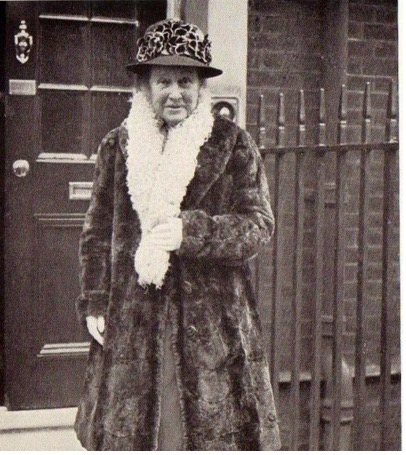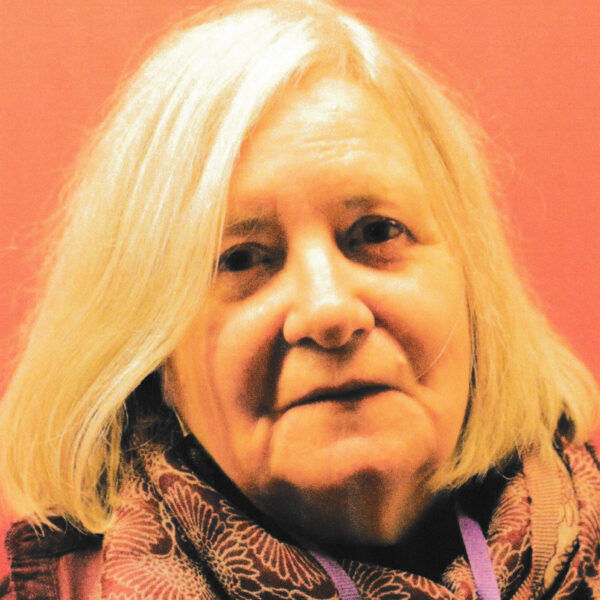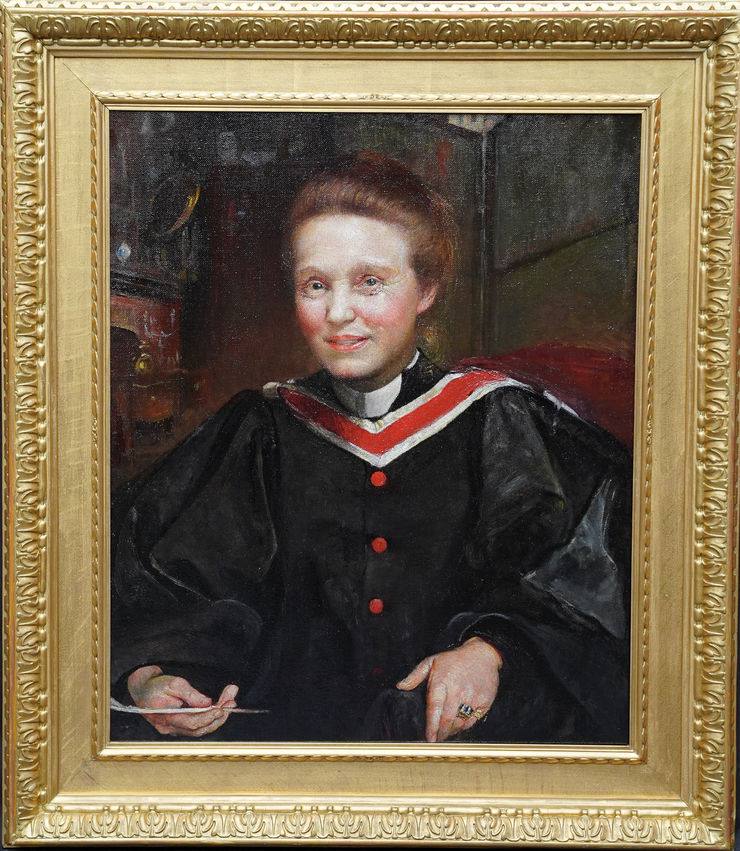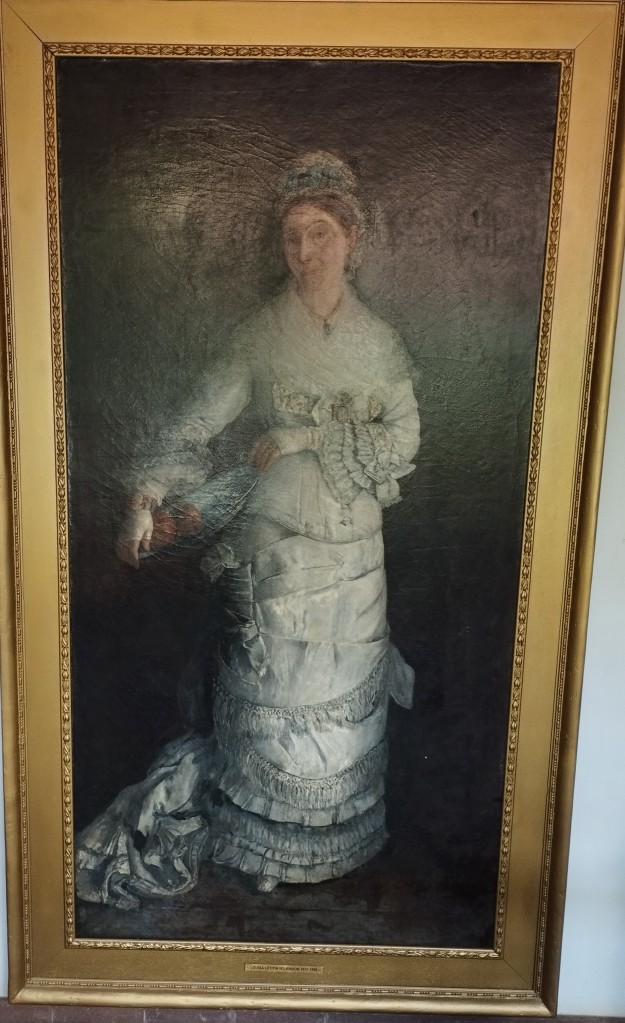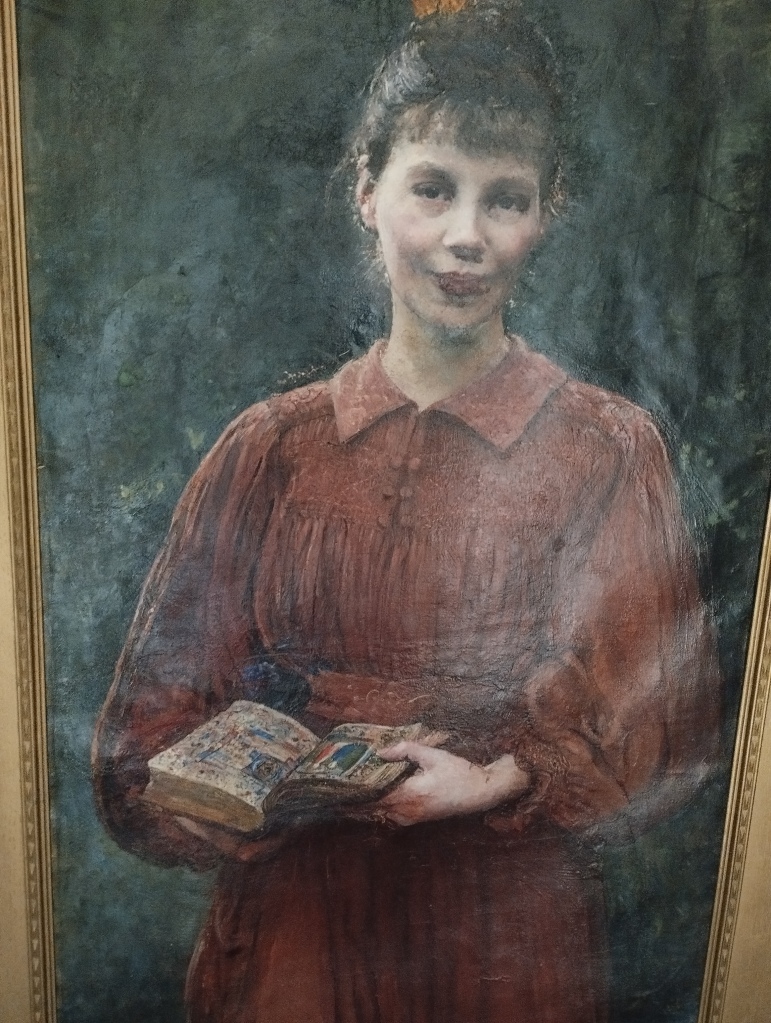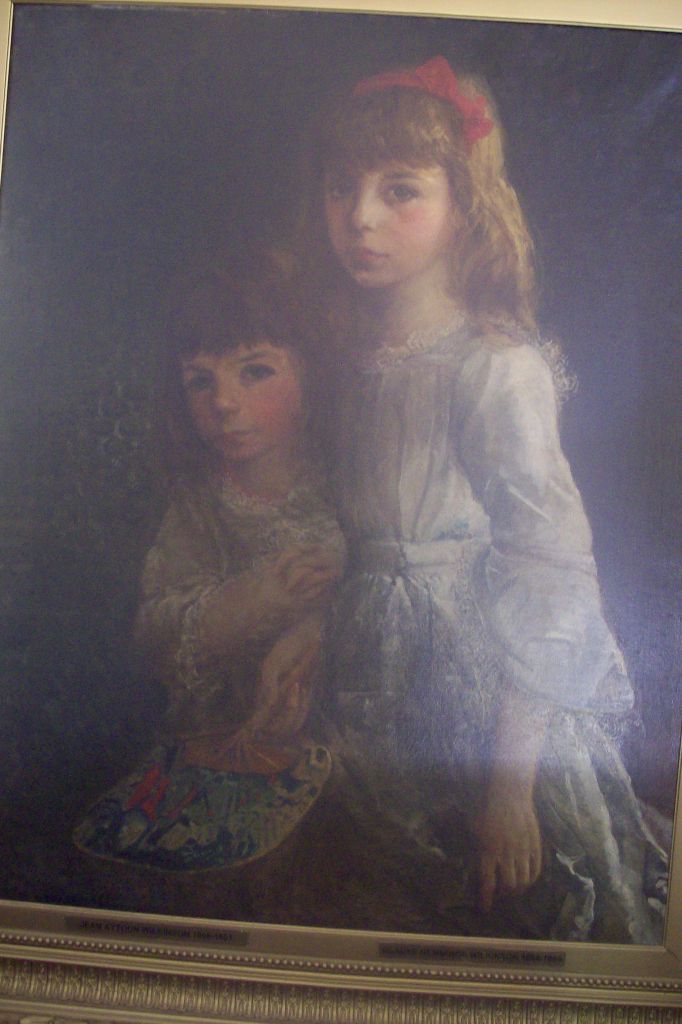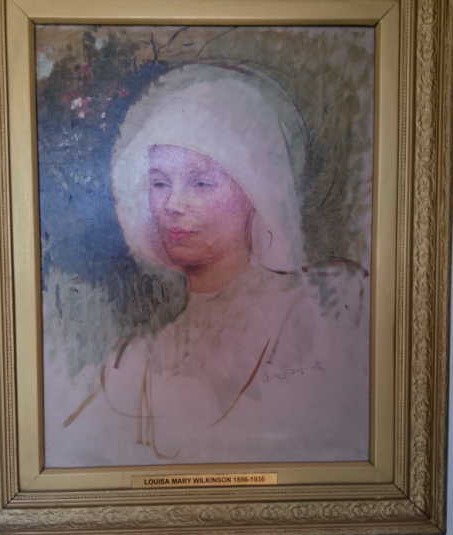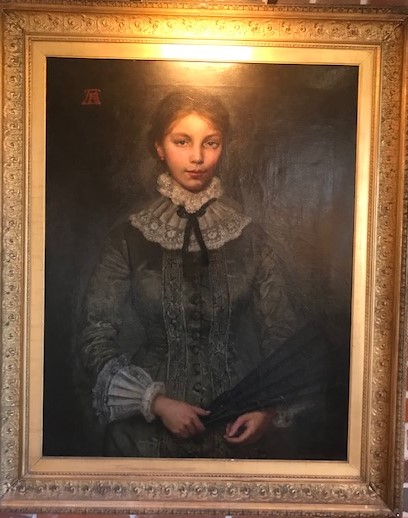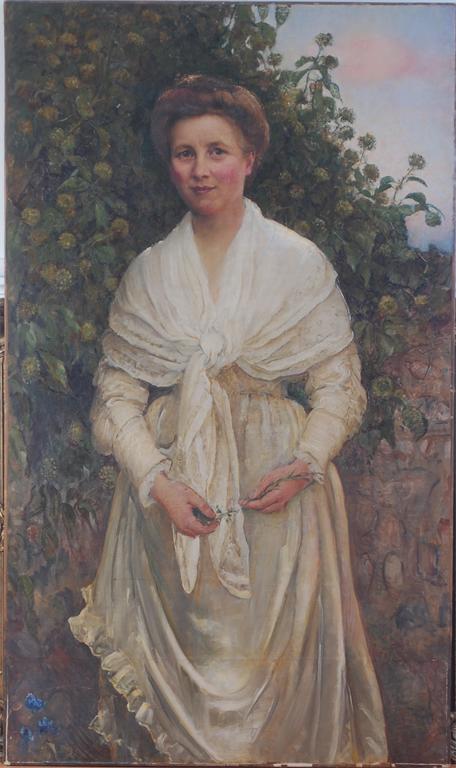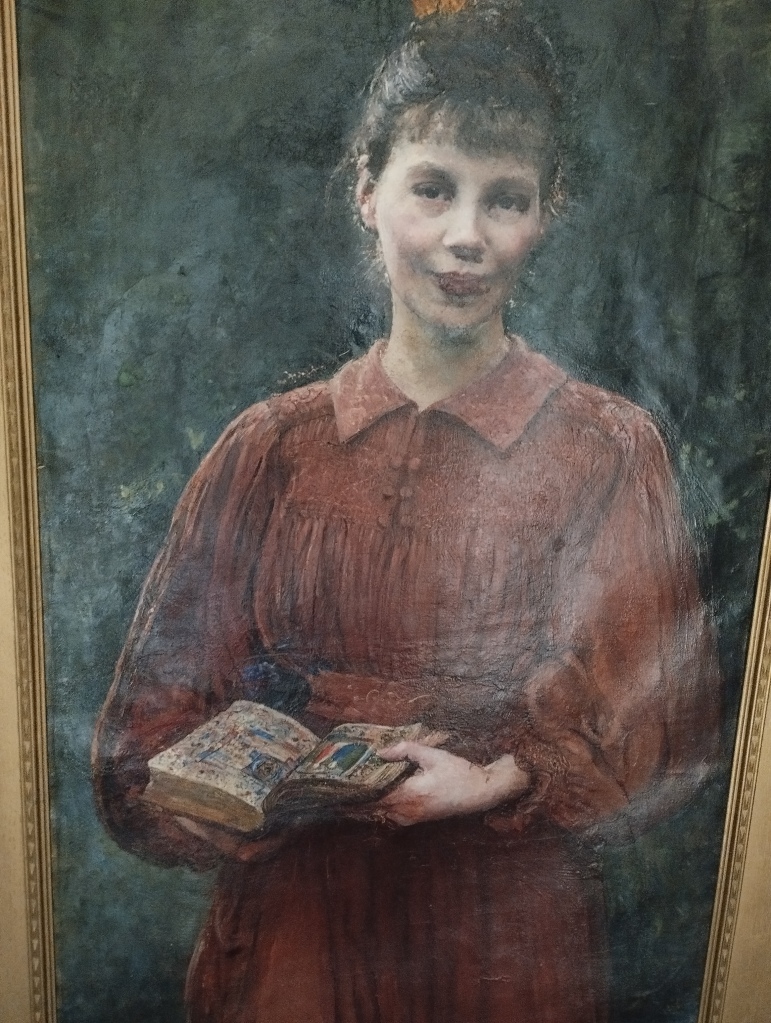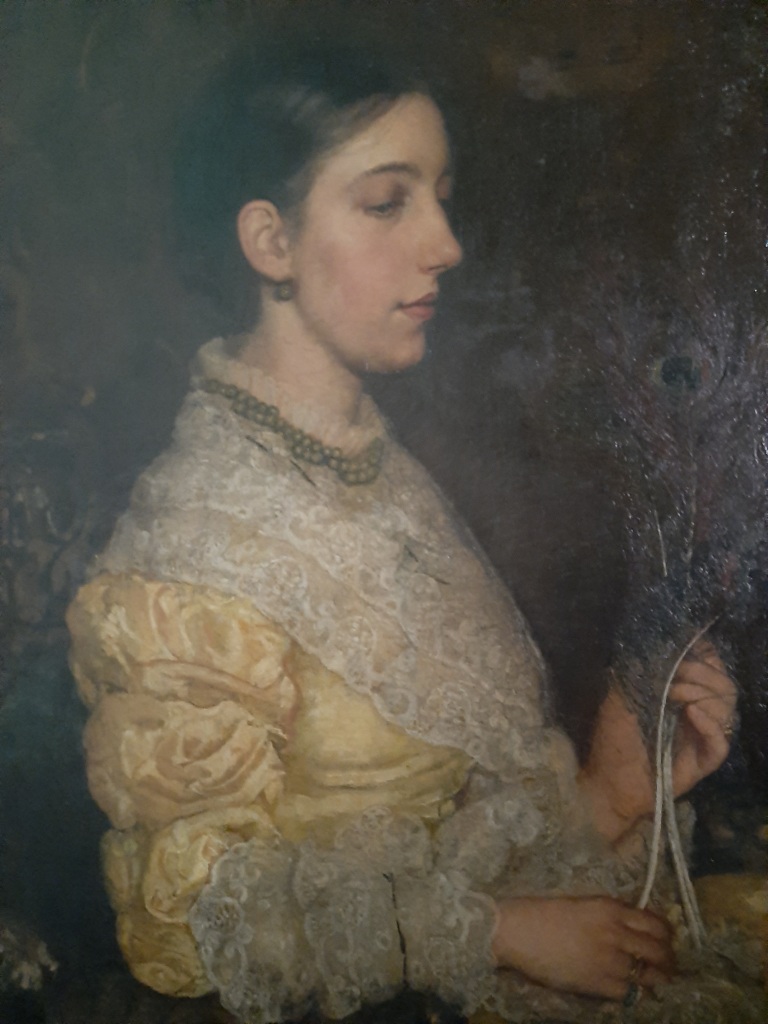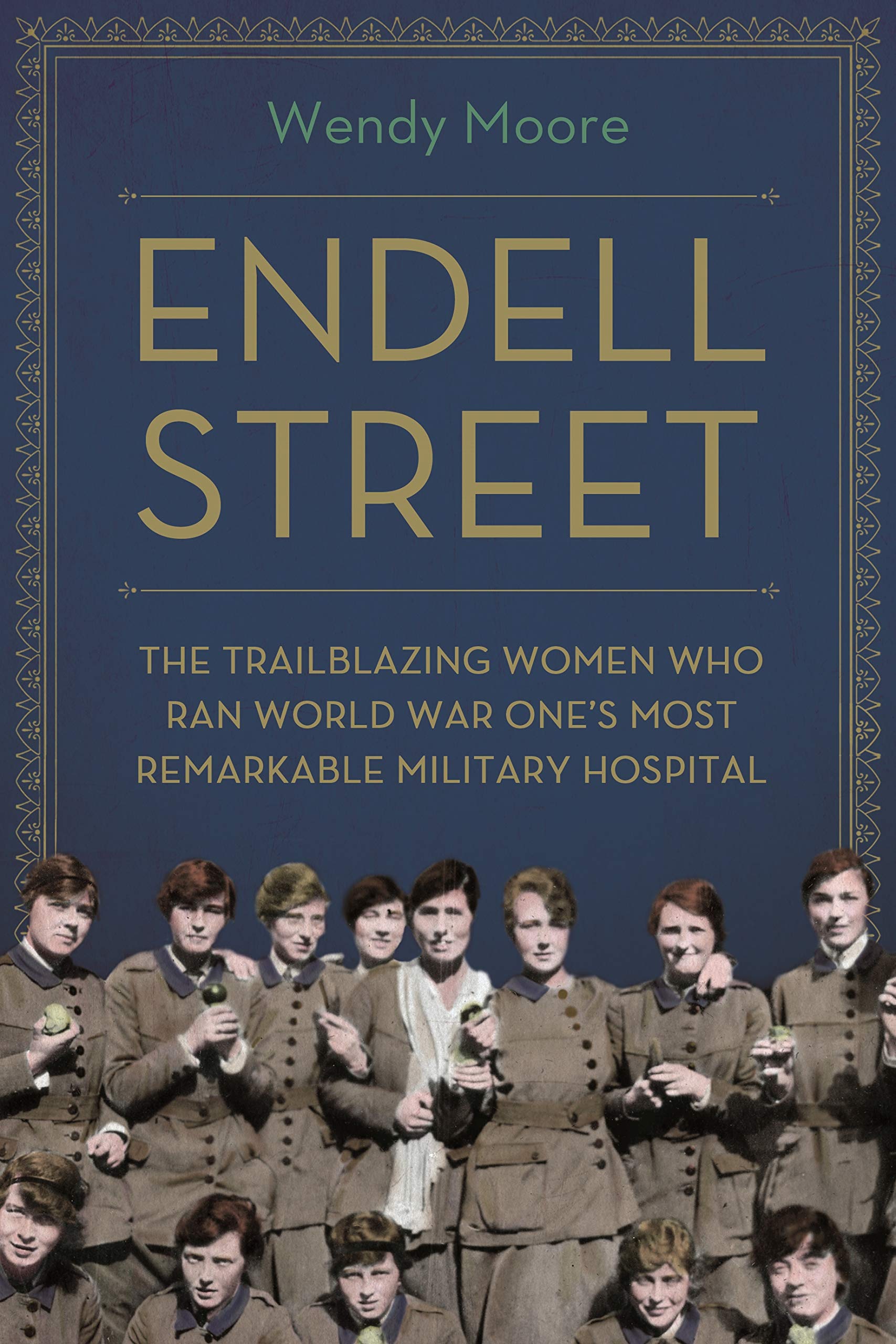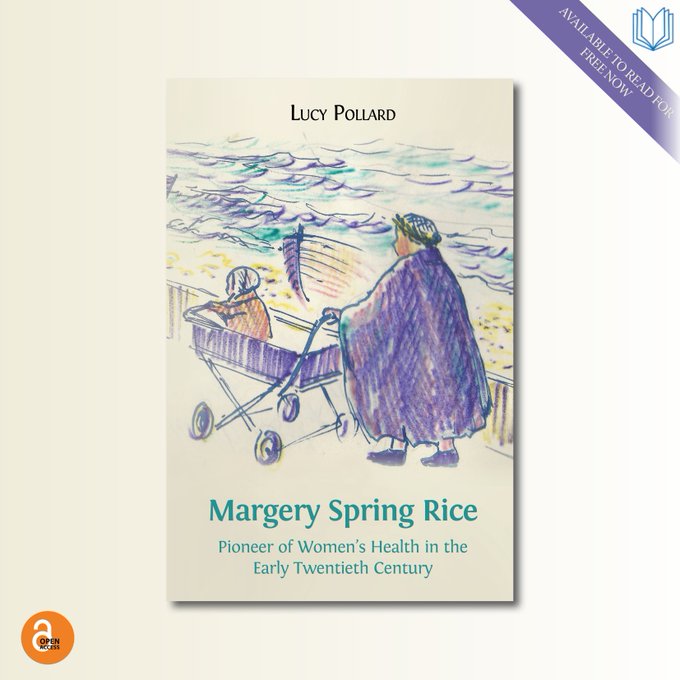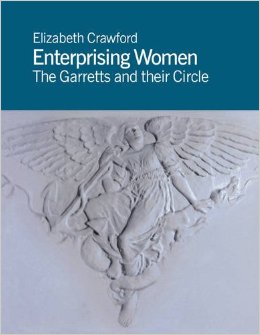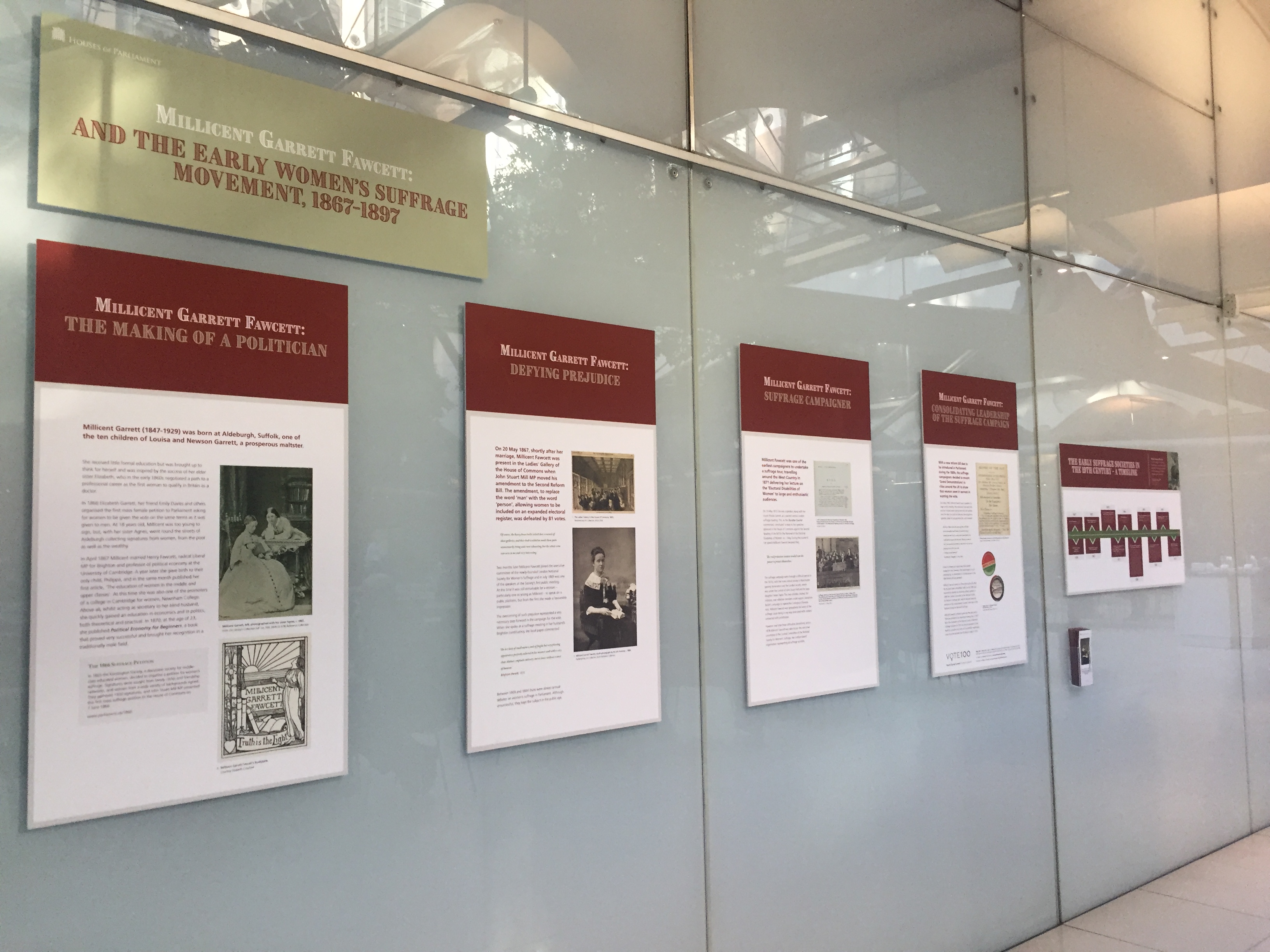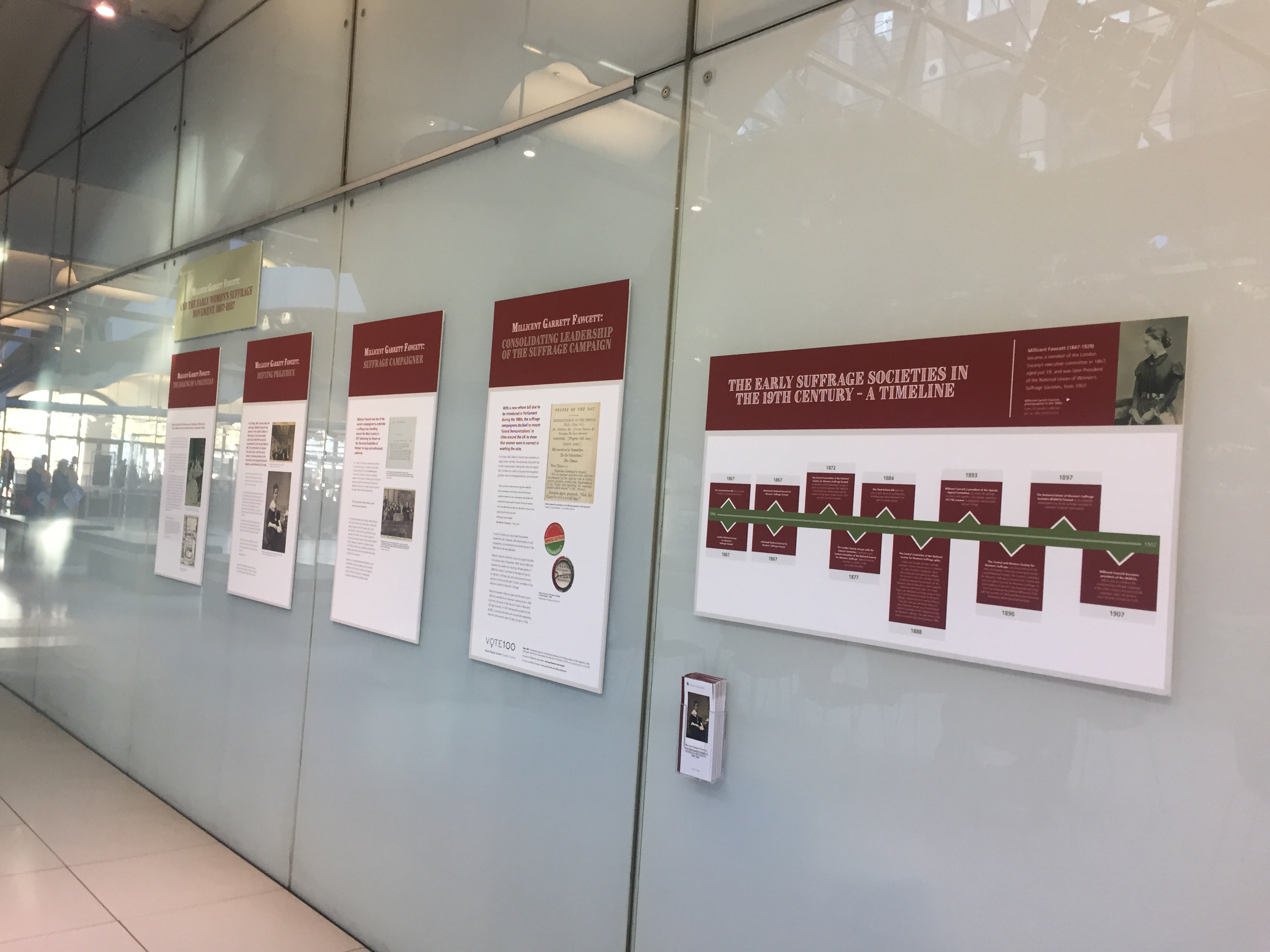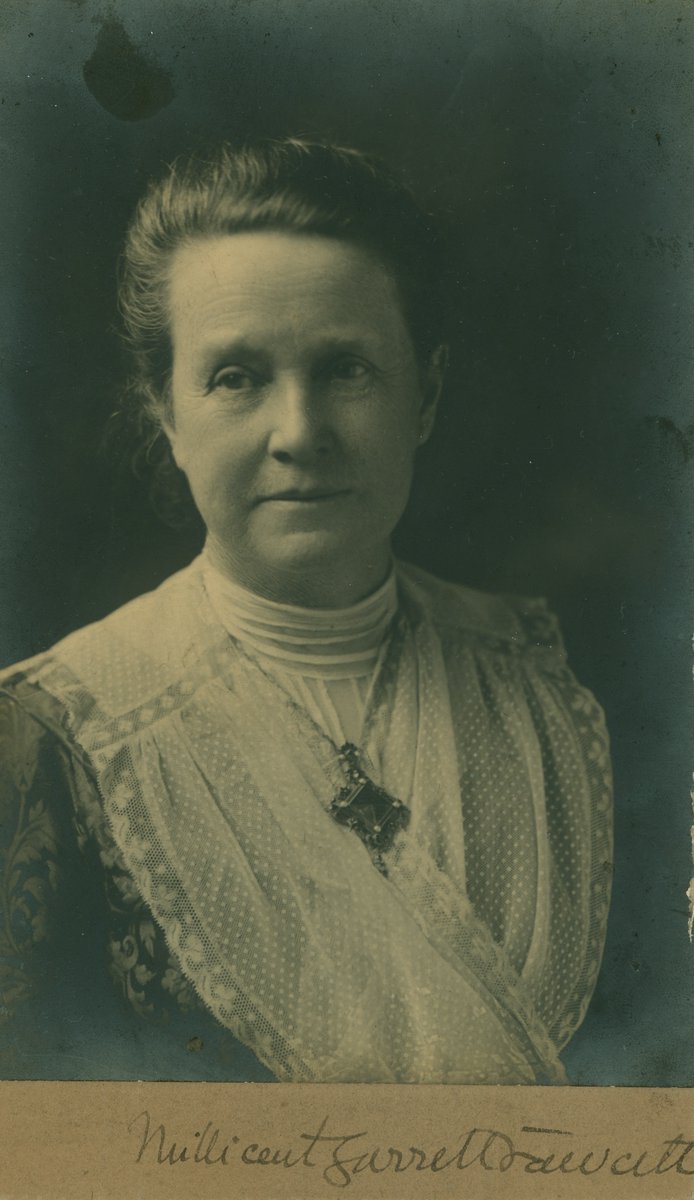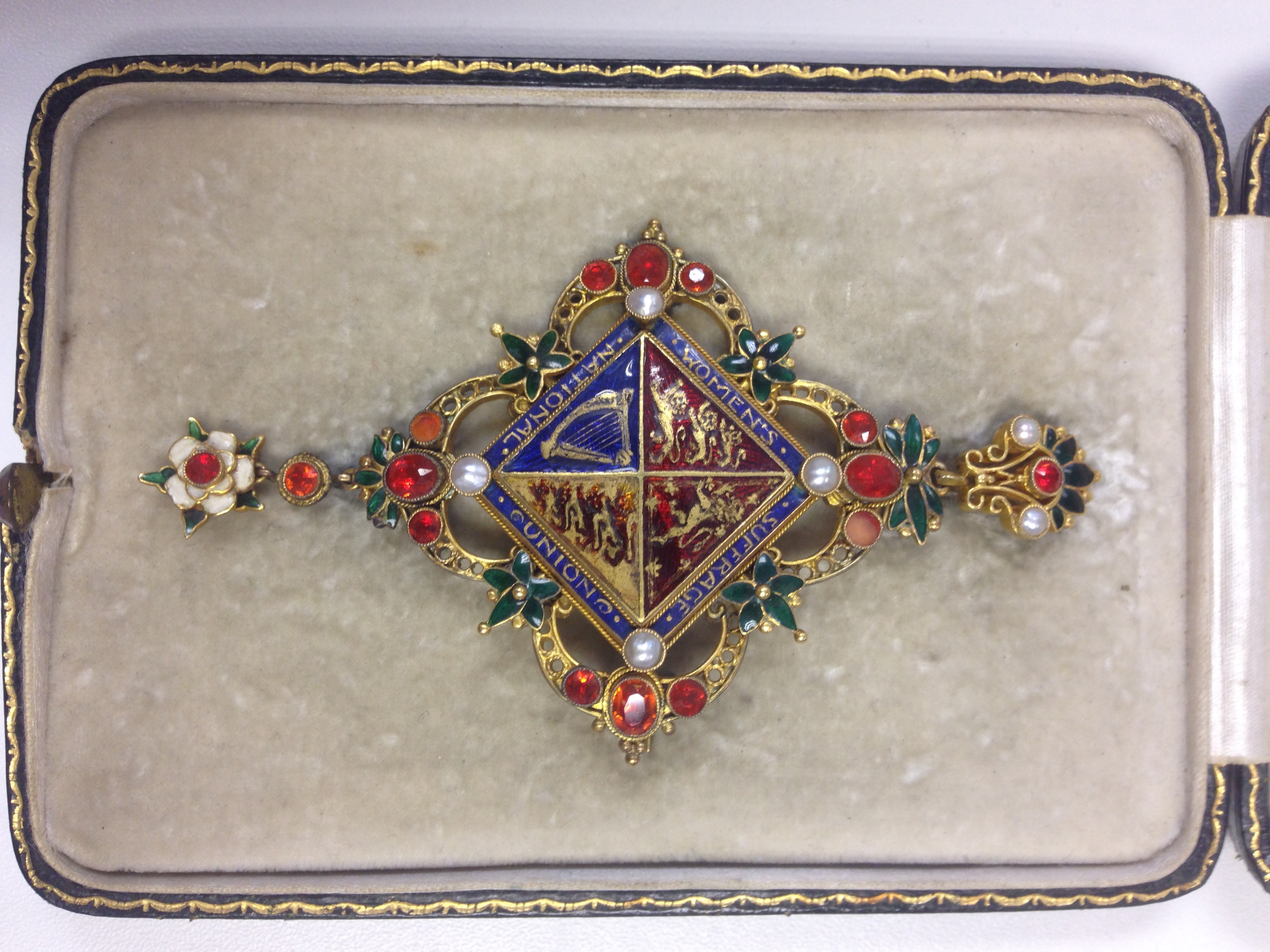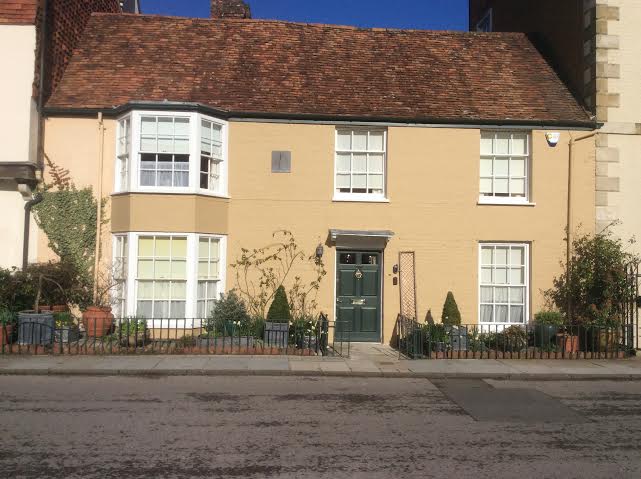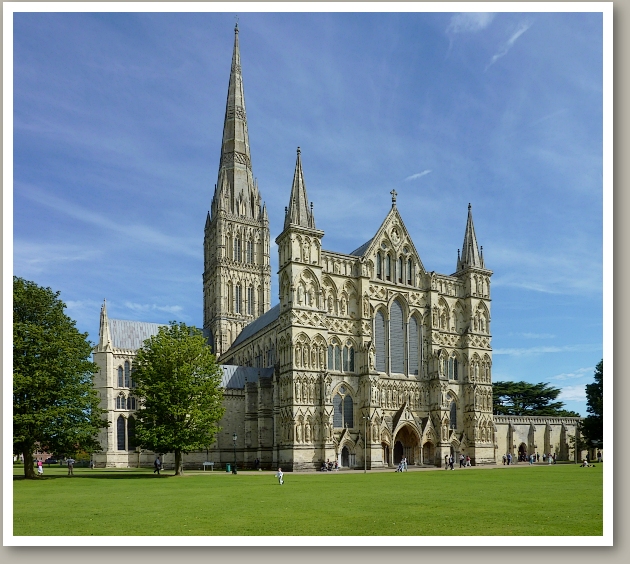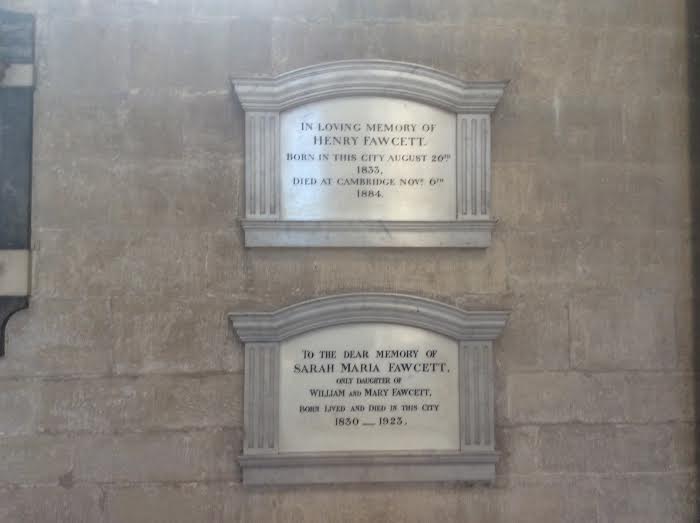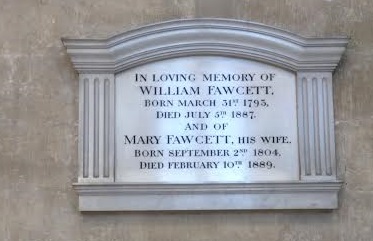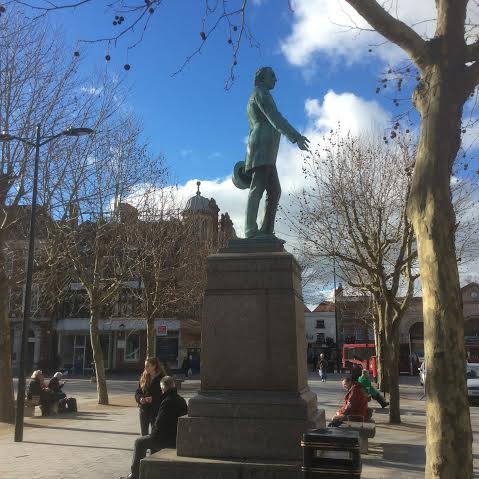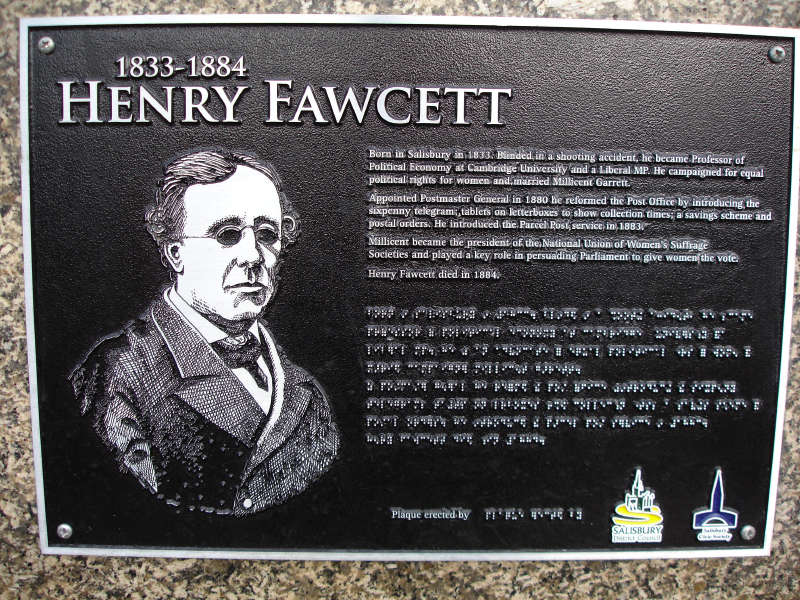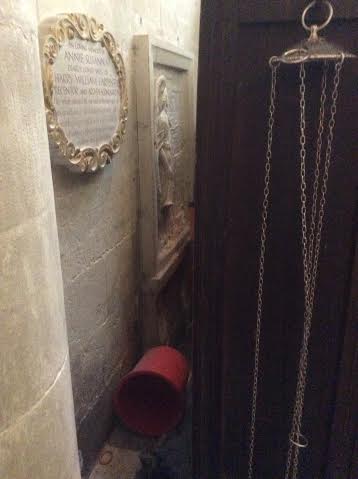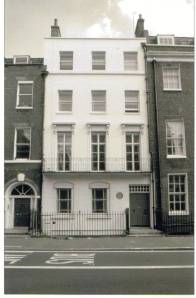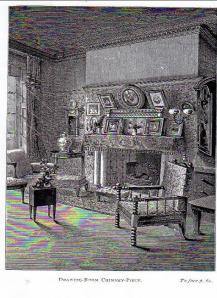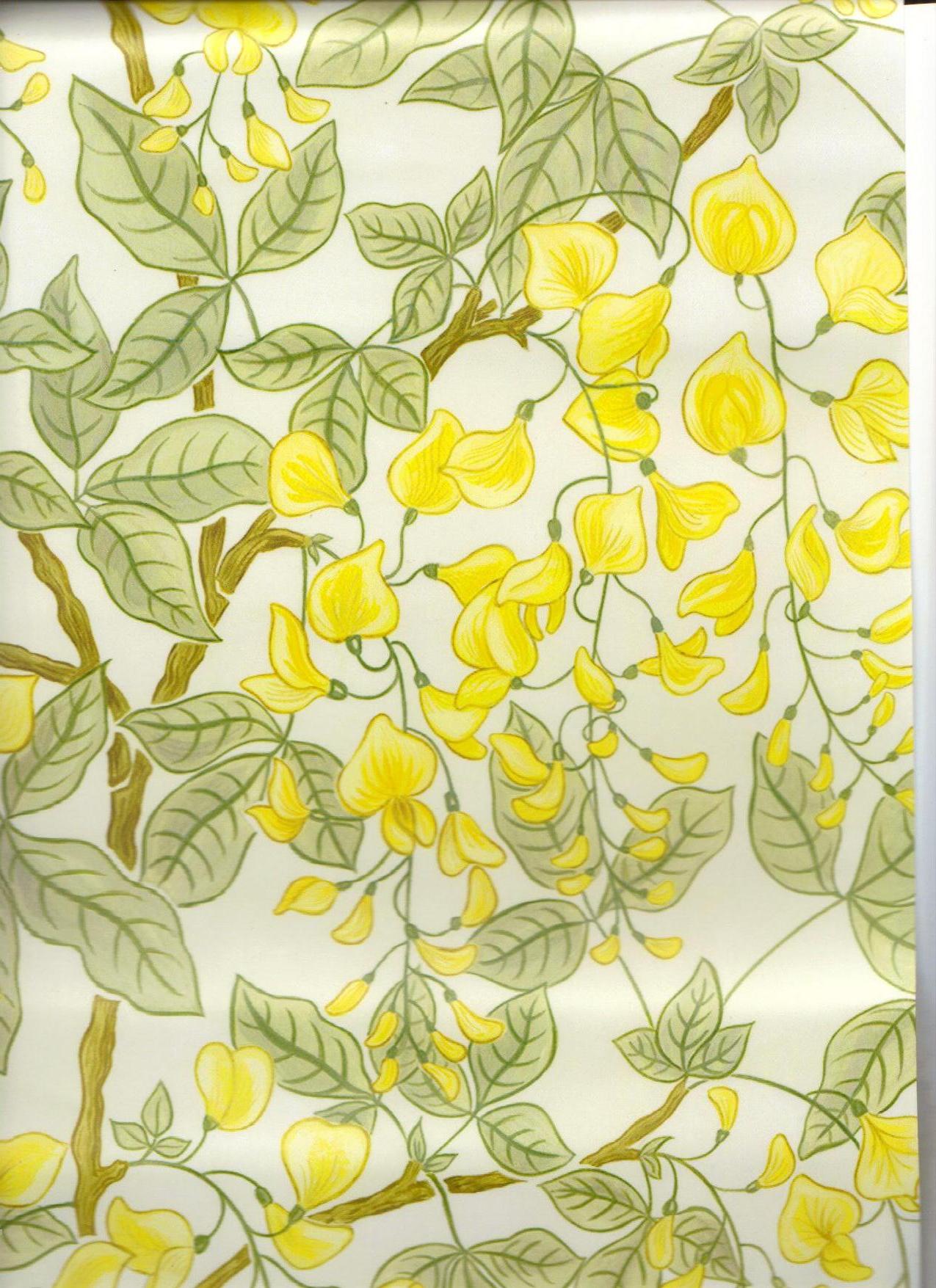Archive for category The Garretts and their Circle
The Garretts And Their Circle: UPDATED: Even More Annie Swynnerton Revelations
Posted by womanandhersphere in Art and Suffrage, The Garretts and their Circle on March 30, 2023
Excellent News: Millicent Garrett Fawcett has now entered Parliament. A portrait of Millicent Garrett Fawcett by Annie Swynnerton, acquired by The Speaker’s Advisory Committee on Works of Art, was ‘unveiled’ on 27 March 2023. The event, chaired (vivaciously) by Jess Phillips MP, was notable for talks on the sitter and the artist by Prof. Melissa Terras and Dr Emma Merkling.
UPDATE
I wrote a long post earlier this month – revealing the existence of previously unknown collection of Swynnerton portraits, the existence of which enhances our knowledge of the artist. Since then I have tracked down one further associated portrait. Rather than merely issuing a short post with the new information, I thought it best, for completeness, to update the existing post. The ‘new’ portrait is discussed towards the end of this article, the main body of which has been amended where necessary.
Millicent Garrett Fawcett by Annie Swynnerton (Courtesy of The Speaker’s Advisory Committee on Works of Art)
It was in July 2022 that I noticed the portrait had appeared in an art dealer’s listing and immediately alerted Melanie Unwin, who until recently was Deputy Collector of the Palace of Westminster Collection – exclaiming, ‘Now, wouldn’t this be an excellent addition to the Parliamentary Collection?’ And – it has come to pass. Public recognition of Millicent Fawcett is something in which I have taken a personal interest – for ten years ago I posted on this website a plea – ‘Make Millicent Fawcett Visible’. And now, lo – the veil has been lifted – she now has a statue in Westminster Square, her portrait, by Annie Swynnerton, is on show in the Tate,[i] and this other version will now hang in Parliament.
This version, which presumably was painted around the same time (1910) as that bought for the Tate by the Chantrey Bequest in 1930 (the year after Fawcett’s death), remained, for whatever reason, in Annie Swynnerton’s studio and was sold in the February 1934 posthumous sale of her ‘Artistic Effects’. After that it passed through the auction rooms on several occasions but since the early 1970s has remained out of sight. However, thanks to the fact that the National Portrait Gallery archive holds a black-and-white photograph, Melissa Terras and I were able to include this image in Millicent Fawcett: selected writings.[ii]
In Enterprising Women: the Garretts and their circle I hazarded a guess that the Tate’s portrait might have been painted in a first-floor back room at Fawcett’s home, 2 Gower Street, Bloomsbury. However, I’ve now discovered, in a recently-digitised newspaper (the wonder of our age), that ‘Mrs Swynnerton told a Daily Herald representative that half of the portrait was painted in the garden of Dame Millicent’s house in Gower Street and the other half at her own home’.[iii]
Which leads me neatly to the bland, but intriguing, observation that a narrative is shaped by the available information. Thus, in biography, an author takes ‘facts’ about a subject and turns them into a ‘life’. If the ‘facts’ comprise primary sources, such as letters, diaries, newspaper articles, society minutes, oral interviews etc, so much the better – or, at least, easier. But if the subject has left no written trace, information must be wrung from whatever material comes to hand.
And, thus, I leap to the particular. For, in the case of the artist Annie Swynnerton (née Robinson), although there is very little documented information about her early life, serendipity – in the shape of a previously unrecorded collection of family portraits – has recently allowed me to focus the biographical lens on one connection made at the start of her career, that ran as a thread through its entirety, ensured her a place in the canon, and effected the link between the artist and the sitter of Parliament’s latest acquisition.
We know Annie Louisa Robinson was born in Manchester in 1844, the eldest of seven daughters. Her father, Francis Robinson (1814-89), the son of a Yorkshire carpenter,[iv] had risen from what one assumes were relatively humble beginnings, to become a solicitor, with a practice in central Manchester. By the mid-1850s he was sufficiently successful to be able to move his growing family from inner Manchester to a newly-built, detached house in leafy Prestwich Park, 5 km north of the city.[v] In fact Robinson was one of the first house-owners in this development which, guarded by two entrance lodges and with fine views, was intended to appeal to the burgeoning Manchester middle-class.[vi] For some years Robinson involved himself in Manchester affairs; in 1863 he was vice-president of the Manchester Law Association and from at least 1861 was a councillor for St Ann’s Ward and by 1868 its chairman. However, in 1869 disaster struck; he was declared bankrupt. The effect on the family was momentous. In March the entire contents of the home – from a ‘Splendid Walnutwood Drawing-Room Suite, ‘’a sweet-toned cottage pianoforte’, ‘stuffed Australian birds under glass shade’ to a ‘patent coffee percolator’, ‘large brass preserving pans’, and ‘300 choice greenhouse and other plants’ – were all sold at auction.[vii] Stripped from the walls were oil paintings by, among others, Sam Bough, John Brandon Smith, and David Cox, and, from the bookshelves, about 500 volumes, among which were Bryan’s Dictionary of Painters and Engravers.
In June the house itself, with its drawing-room, two dining rooms, breakfast room, library, nine bedrooms, bathrooms, pantries, sculleries, and about half an acre of land, was sold.[viii] The family was then split up. The 1871 census shows Annie (27, Artist), living with her sisters Emily (26, Artist), Julia (24, Artist), Mary (Scholar 16) and Frances (Scholar, 14) in lodgings at 28 Upper Brook Street, back in central Manchester, while Sarah (22) and Adela (19) were visiting with Mrs Sarah Robinson, an elderly widowed relation, and their aunt Mary on the other side of the same street, at number 13.[ix] There is no trace of the Robinson parents in the census but, wherever they were, on census night at least, they were not living with any of their daughters. We must assume that the older sisters now had responsibility for the younger two, who were still at school.
We have no information as to where or how Annie and her sisters were educated. The 1861 Robinson household census does not include a governess, so we can probably conclude that the girls attended a school.[x] Published 30 years later, a brief biographical article in The Queen gives us a rare insight into the Robinson sisters’ early life.[xi]
‘Curiously enough, whilst neither parent had any taste in that direction, Mrs Swynnerton’s two sisters Emily and Julia, were, like herself, born artists, and are both practising their profession in Manchester. When of the tender age of from eleven to thirteen years, Miss Annie used to delight her playfellows, visitors to the house, and the servants with exhibitions of specimens of her very juvenile skill in the shape of water-colour drawings. These primitive works were produced without the advantage of any instruction, and were simply the spontaneous efforts of an inborn, absorbing love of art.’
The Queen commends Francis Robinson for recognising his eldest daughter’s talent and states that ‘she was early placed in the art school at her native city, Manchester’, making no mention of the family’s financial disaster that probably necessitated, or, at least, precipitated, this development. Bankruptcy was unlikely to have struck suddenly and Annie and her sisters may well have been aware of impending disaster. That may be why, from sometime from 1868, Emily, Annie and Julia enrolled as students at the Manchester School of Art. Sensible young women knew a training was necessary if a living was to be earned. Certainly by 1870/1871, with the security they had once enjoyed swept away, the three oldest Robinson sisters were all attending classes at Manchester School of Art.[xii] Here Annie excelled and in 1873 was awarded one of the 10 national gold medals and a Princess of Wales scholarship worth £11 for ‘Group in oils’.[xiii] Julia was presented with a bronze medal and Emily a book prize.[xiv]
In tracing Annie’s developing career I will continue with the known facts and return later to suppositions. Thus, the narrative runs that in 1874 Annie Robinson travelled to Rome with her friend Isabel Dacre to study and paint, returning to Manchester in 1876. We do not know exactly when in 1874 they left Manchester, nor exactly when in 1876 they returned. But we do know that Annie exhibited a painting at the Manchester exhibition in March 1877.[xv]
Mrs Louisa Wilkinson by Annie Swynnerton (credit Kenneth Northover)
Annie was again successful the following March (1878) in having another painting selected to hang in the Manchester exhibition. Most importantly, this was the first of her works to which the name of the subject was attached, a name that was then included in the press reports. [xvi] The painting was a full-length portrait of Mrs Louisa Wilkinson and is the first, dated, evidence of Annie’s lifelong friendship with the Wilkinson family, about which I write in Enterprising Women. When researching and writing that book, I guessed that the Wilkinsons, a leading Manchester family, were likely to have been the conduit through whom Annie entered the Garrett Circle, but until recently I had no material proof of when the connection might first have been made.
Revelation struck in June 2022 on a particularly serendipitous occasion, held to mark the installation, on her one-time Bloomsbury apartment, of an English Heritage Blue Plaque to Fanny Wilkinson (1855-1951), Britain’s first professional woman landscape gardener. It was my research on Fanny, published in Enterprising Women, that directed attention to her work, and I was delighted to listen as a descendant of her youngest sister gave a talk about the Wilkinson family – and was astounded when a portrait of Fanny, by none other than Annie Swynnerton, appeared on the accompanying Powerpoint. During the reception that followed I was thrilled to discover that a South African branch of the family held other portraits of family members painted by Annie, both before and after her marriage. This cache of paintings, previously unknown to the art world, presents us with a key to unlock more information about Annie’s career.
For among these family portraits is the painting of Mrs Louisa Wilkinson (1823-89) that was exhibited in Manchester in 1878. Here she is, fashionably attired in satin, lace, and jewels, her dress, with its swagging, rosettes, ruches, and train, affording Annie every opportunity of displaying a bravura technique. The Wilkinsons were wealthy and philanthropic; there is no doubt that Annie would have been well paid for the portrait. In addition, by permitting her portrait to be exhibited and allowing herself to be named, Mrs Wilkinson was furthering Annie’s cause by advertising her skill. To attract clients from Manchester’s prosperous middle-class an artist had to be able to display their work. Were the Wilkinsons Annie Robinson’s first significant clients?
It may be that Annie received similar portrait commissions at this time but because they were not exhibited by name (or, indeed, have subsequently passed through the auction rooms with no name attached) they are now unknown. The one portrait by Annie that did receive attention in the late 1870s was that of the Rev. W. Gaskell, widower of the novelist Elizabeth Gaskell, which was commissioned by the Portico Library. It was the Rev. Gaskell himself who in 1879 chose to be painted by Annie, remarking ‘My daughters tell me that she has painted a portrait which they like very much.’[xvii] Could it have been the portrait of Mrs Louisa Wilkinson to which they were referring?[xviii]
For the Gaskells and Wilkinsons must surely have known each other. Dr Matthew Eason Wilkinson (1813-78) was Manchester’s leading doctor and his wife, although born in the US, was descended from a radical Manchester family. The Wilkinsons took an interest in art; Fanny, the eldest, put an artistic ‘eye’ and practical ability to good use in forging a novel career, while both Louisa (1859-1936) and Gladys (1864-1957) studied art in London and had works exhibited.
But, to return to the portrait of Mrs Louisa Wilkinson. To have been exhibited in March 1878, this portrait must have been painted sometime earlier, which places Annie firmly in Manchester for at least some of 1877 and, probably, part of 1876. It so happens that the ‘manly, intellectual head’ of Mrs Wilkinson’s husband, Dr Matthew Eason Wilkinson, was, in the autumn of 1877, on display in the studio exhibition of a sculptor, Joseph Swynnerton.[xix] I think, therefore, we can be certain that, whether or not they had known each other previously (and surely they had), the artist and the sculptor must have encountered each other at this time, as they each immortalised Wilkinson père and mère, a pattern repeated the following year when they both produced portraits of the Rev. Gaskell, one in oils and one in marble.
Louisa Wilkinson – second daughter of the Wilkinson family (credit Kenneth Northover)
It was another eleven years before another Annie Swynnerton portrait of a fully-named member of the Wilkinson family was exhibited – and that is this full-length portrait of Louisa Mary Wilkinson, shown at the New Gallery in April/May 1889 . The change of style is remarkable. Louisa was described in the Pall Mall Gazette as ‘a slim figure with an old-fashioned face out of a Dutch picture standing among bluebells and clasping an illuminated missal,[xx] while the Birmingham Daily Post considered it a ‘very original and unconventional portrait, which we found a great deal more human and interesting than the silk and satin gowns with long trains, the feather-fans ad bric-a-brac, with figure-heads attached’.[xxi]
It is now possible to insert a biographical ‘fact’ that may give a slight narrative depth to this picture. For when it was painted, 1888/9, although renting a studio at 6 The Avenue (76 Fulham Road), Annie and Joseph were actually living in Bedford Park, the ‘Queen Anne’, ‘Sweetness and Light’, suburb so popular with artists, their house, 18 St Anne’s Grove, having a purpose-built studio on the top floor.[xxii] At the same time, Mrs Louisa Wilkinson was also a resident of Bedford Park. Although Fanny was living in Bloomsbury, it’s likely that Louisa and her younger sisters lived, at least some of the time, with their mother.[xxiii] I don’t think it too fanciful to suggest that the younger Louisa Wilkinson may have been painted in Bedford Park – standing amongst bluebells (the image I reproduce is, perforce, cropped) either in the garden of Annie’s house or that of her mother.
A few years earlier Louisa had been recorded in the 1881 census as an art student, exhibited that year in the Dudley Gallery and in 1882 at the Walker Gallery, and later turned her hand to book binding. Thus, it’s fitting she’s depicted wearing Artistic Dress, her loose linen garment, with tucks, shoulder embroidery and bodice smocking, cinched by an embroidered belt, hinting at an artist’s smock. She wears no necklace or earrings, the illuminated missal offering sufficient jewelled colours. Perhaps she had bound the missal herself.
In 1894 Annie exhibited the portrait again, including it in a Society of Lady Artists exhibition. Fortunately, the review in The Queen allows us to identify this as the same portrait, by including a description of ‘Portrait of Miss Louisa Wilkinson’: ‘a finely executed picture of a lady facing the spectator, holding, apparently, an illuminated missal in her hands. There is a strong sense of harmony in the scheme of colour, in which a reddish-brown costume plays a not inconspicuous part’. [xxiv] The Manchester Evening News described the portrait as a ‘very “new English” full-length study’.[xxv] Although Annie was not elected a member of the New English Art Club until 1909, she had long been responsive to works by such earlier members as George Clausen.
The two paintings, so different in style – that of Mrs Louisa Wilkinson exhibited in 1878 and her daughter, Louisa, in 1889 – are the only two of Annie’s Wilkinson portraits that were exhibited by name. But they are not the only family portraits by her still held by Wilkinson descendants. As I’m keen to keep supposition separate from known facts, I’m now discussing these separately, rather than inserting them into the known Annie Robinson/Swynnerton chronology.
Jean (on the left) and Gladys Wilkinson (credit Kenneth Northover)
It is possible that the above portrait could have been the first that the Wilkinson family commissioned from Annie. The biographical article published in The Queen mentions that Annie’s ‘.. first picture was a profile picture of a girl’s head, and this she followed with a group, two half-length portraits, called “Gladys and Jean”, which was in the Manchester exhibition.’
Gladys and Jean were the youngest members of the Wilkinson family, born in 1863 and 1876. How old do you think they look in this painting? To me it doesn’t seem possible they could be older than 11 and 7 respectively and that, if so, the double portrait must have been painted no later than 1873/1874, before Annie’s departure abroad.[xxvi] Even in this imperfect photo, we can see that the girls’ satin and lace dresses – and the fashionable Japanese fan held by Gladys – have been lovingly detailed by Annie. It seems plausible that the Wilkinson parents would have commissioned a smaller portrait of their youngest daughters, as a test run, before incurring the expense of a full-length painting of their mother. If The Queen journalist was correctly informed and the painting was indeed exhibited in Manchester, it could have been included in the 1875 Royal Manchester exhibition, the first for which ‘lady exhibitors’, of whom Annie was one, were eligible.[xxvii] Or could it even have been the ‘group in oils’ (which is an echo of the term used of ‘Gladys and Jean’ in The Queen)for which Annie won her Princess of Wales scholarship in 1873? But that is probably too fanciful – and an illustration of how dangerous it is to view a ‘biography’ through a single lens.
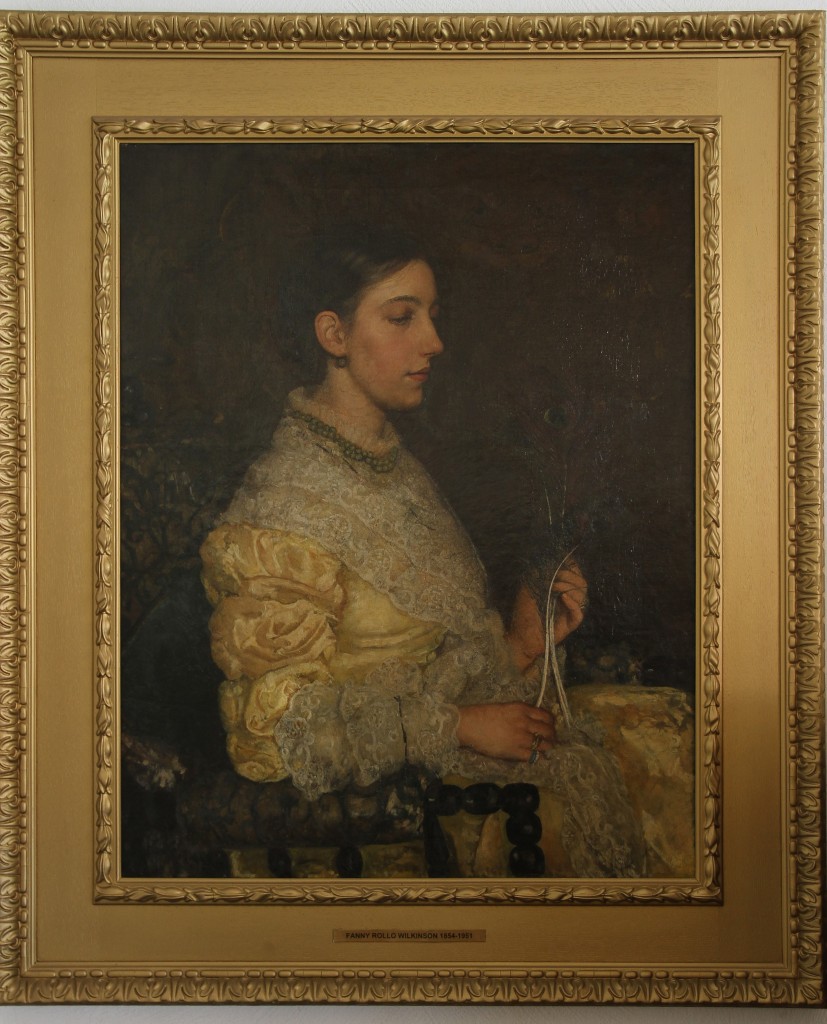
Fanny Wilkinson by Annie Swynnerton (credit Kenneth Northover)
Here, now, is the portrait of a demure Fanny Wilkinson that put me on the trail of the cache of ‘Wilkinson’ paintings. Although it probably does carry a date, that cannot be seen at the moment, and, although it’s possible to gauge the age of young children such as Gladys and Jean, it’s more difficult to do so for a young woman. Although I cannot decide whether it was painted before or after Annie’s stay in Rome (1874-6), I think we can be certain that the portrait was painted before the death of Dr Wilkinson in Autumn 1878 and the family’s consequent move from Manchester to Middlethorpe Hall in Yorkshire.
Fanny is depicted as decidedly ‘Artistic’, the sleeves of her dress bound in a quasi-medieval style, a lace fichu flowing over the bodice, complementing the frothing cuffs. Although we cannot see the whole shape of her dress, it certainly appears more relaxed than her mother’s ruched and flounced costume. The peacock feathers were, of course, the height of Aesthetic accessorizing. The accomplished painting of the yellow satin and the lace once again advertised the artist’s skill. I wonder if the portrait was ever exhibited? I don’t think it can be the ‘profile picture of a girl’s head’ mentioned in the 1890 Queen article – as it’s so much more than ‘a head’.
Louisa Wilkinson by Annie Swynnerton (credit Kenneth Northover)
This is the last of this particular collection of Wilkinson portraits – a sketch of Louisa in a sun bonnet. It is signed ‘A.L. Swynnerton’ and so can be dated to no earlier than 1883 – and her marriage to Joseph – but could perhaps be any time after 1887 (for in that year she was still signing paintings as ‘Robinson’) but before Louisa’s marriage to George Garrett in 1900 (because the title on the frame refers to her as ‘Wilkinson’).[xxviii]
This marriage merely formalised the link between the Garrett and Wilkinson families, the women having already been bound for over two decades in friendship and shared enterprises, with Annie as their preferred portraitist. However, besides the portraits noted above, I knew that Annie Swynnerton had painted another portrait of Louisa Garrett/Wilkinson because I had, very much in passing, seen it when researching Enterprising Women, well over 20 years ago. It was then hanging in a house in Aldeburgh, the home of the widow of a descendant of the wider Garrett family who had inherited ‘Greenheys’ (the Snape home of George and Louisa Garrett). I was there attempting to track down information on the work of Rhoda and Agnes Garret and, although noting the portrait with interest, did not, at the time, record it in any way. But, its existence, if not its form, remained in my memory and in very early 2020, shortly before Covid descended, I set out to try and track it down – and yesterday succeeded.
Louisa Wilkinson (later Mrs George Garrett) by Annie Swynnerton (credit Peter Wood)
The portrait of Louisa Wilkinson is particularly interesting for having Annie Robinson’s monogram prominently displayed in the top left corner. Moreover, I believe it is the painting, catalogued as ‘Louise’, that Swynnerton exhibited at the Walker Gallery, Liverpool, in September 1878. The critic in the Liverpool Mercury (23 September 1878) praised it as ‘A very pleasing and clever picture, unassuming in character of both work and individual; no ostentation, no gilding of nothingness, but a really fine painting. A young and thoughtful face, neat costume, chaste subdued colouring, and good workmanship, make it a work of beauty and promise much to be admired.’
I think, too, that this is ‘Portrait of a Lady’ that Swynnerton exhibited at the Royal Academy in 1879. I make this deduction from an intriguing comment made in the course of an article about Swynnerton that appeared in the 1890 Queen article. In it the writer remarks of her work that ‘An excellent picture, “Louise”, was placed on the line at the RA, this being succeeded by “The Tryst”.’
It is difficult to interpret this remark. Although ‘The Factory Girl’s Tryst’ was shown at the RA in 1881, preceded in 1879 by ‘Portrait of a Lady’ and in 1880 by ‘Portrait of Miss S. Isabel Dacre’, Annie doesn’t appear ever to have exhibited any ‘Louise’ (or ‘Louisa’) at the RA. Unless, of course, the Queen journalist was told that the 1879 ‘Portrait of a Lady’ was that of a particular ‘Louise’ (or ‘Louisa’), in which case it must surely be the portrait exhibited in Liverpool the previous year.
In 1879 The Athenaeum’s reviewer described the RA portrait as of a ‘lady in a grey citron dress, standing against a grey background [which] shows profitable studies of old Italian portraiture with Dutch vraisemblance, and is the first-rate example of the harmonious treatment of low tints and tones in a manner that is not decorative ‘[xxix] What do you think? Could this accord with what you see in the portrait of Louisa Wilkinson? After Liverpool in 1878, was she re-shown at the RA in 1879? As we can see, from the three known portraits, Louisa Wilkinson/Garrett was one of Swynnerton’s favourite subjects. If this was the first, Louisa would have been c 19 in 1878, an age consonant with the sitter of ‘Louise’, Knowing that Swynnerton had also recently painted her mother and three of her sisters, it seems entirely credible that this portrait of Louisa would have been painted in 1878 and, hence, that it is the portrait exhibited at the Walker Gallery and the Royal Academy.
I also know that, over the years, Swynnerton painted Louisa Garrett Anderson (daughter of Elizabeth Garrett Anderson and niece of Millicent Fawcett) and Rhoda Garrett (cousin and partner of Agnes Garrett), although their whereabouts is not now known. However, in the course of researching this article I think I have made one discovery.
Agnes Garrett by Annie Swynnerton (courtesy of Lacy Scott and Knight)
For, on Jonathan Russell’s excellent website, under details of the paintings shown at the 1923 exhibition of Annie’s works, I came across this – described as ‘Portrait of a lady standing by flowering ivy’. It was sold, unframed, at auction twice, in quick succession, in 2014.[xxx] I am certain that this is the portrait that Annie painted of Agnes Garrett – at Agnes’ holiday home in Rustington, in the summer of 1885. The subject not only looks like Agnes, but I can see Sussex knapped flints in the wall behind her. This painting was included in the 1923 Manchester exhibition of Annie’s works – and I know that Agnes’ portrait was also there, in Room 7, lent by her sister-in-law, Louisa Garrett. This must surely be it.
In Enterprising Women I describe in detail how the Wilkinsons, the Garretts, and other members of their circle did so much – through their ‘matronage’ – to ensure Annie Swynnerton’s presence on art gallery walls. And she, in turn, has ensured that her friends and associates, as they hang on the walls of family homes, are still known to their descendants.
You can find other posts about Annie Swynnerton on this website by putting ‘The Garretts and their Circle’ into the Searchbox.
For International Women’s Day 2023 the Pre-Raphaelite Society invited me to talk about Annie Swynnerton. You can find the resulting 2 podcasts here.
[i] When, c. 2000, I was researching Enterprising Women:the Garretts and their circle (Francis Boutle, 2002) the I had to visit the Tate storage facility in order to view the Swynnerton portrait of Millicent Fawcett. It was subsequently shown in Wales, at Bodelwydden Castle, but returned to London for the suffrage centenary in 2018.
[ii] M. Terras and E. Crawford (eds), Millicent Garrett Fawcett: selected writings, UCL Press. Free to download https://discovery.ucl.ac.uk/id/eprint/10149793/1/Millicent-Garret-Fawcett.pdf p 315.
[iii] Daily Herald, 7 May 1930, 1. Swynnerton’s home and studio in 1910 was 1a The Avenue, 76 Fulham Road, London W.
[iv] Information from Francis Robinson’s Articles of Clerkship, 1836 via Ancestry.
[v] I note that the two youngest Robinson daughters were both born in Prestwich. The elder, Mary, was baptised at St Mary’s, Prestwich, on 3 March 1856.
[vi] For something on the history of Prestwich Park see https://www.bury.gov.uk/CHttpHandler.ashx?id=5382&p=0. In the advertisement for the sale of the Robinsons’ household goods in the Manchester Courier, 6 March 1869, the house was described as ‘the second house from the Bottom Lodge, Prestwich Park.
[vii] Manchester Courier,6 March 1869.
[viii] Manchester Courier, 5 June 1869.
[ix] C. Allen and P. Morris, Annie Swynnerton: painter and pioneer, Sarsen Press, 2018, identifies the widowed relation as Francis Robinson’s stepmother
[x] In 1861 Miss Hannah Dickinson’s Ladies’ College opened at Hill-side House, in Prestwich Park, close to the Robinsons’ home. Although Annie would have been then too old, it’s unlikely that even her younger sisters were pupils, as Its fees, even for day girls, were high, 16-20 guineas per annum. Miss Dickinson stressed that she had chosen Prestwich Park for its ‘beautiful scenery, its rural glens, its retired walks, and salubrious breezes – as well as ‘its kind-hearted inhabitants’. Miss Dickinson, Thoughts on Woman and Her Education, Longman Green, 1861, p2
[xi] The Queen, 15 March 1890.
[xii] No firm, primary, evidence has come to light as to when exactly the sisters – either individually or together – enrolled at the School of Art. However, Allen and Morris (p. 19) have established very persuasively that Emily ‘was certainly there from at least autumn 1868’ and that Annie, too, had probably been enrolled in 1868, and Julia certainly by 1869-70.
[xiii] Manchester Evening News, 20 August 1873.
[xiv] Manchester Courier, 13 July 1874.
[xv] It was only in 1875 that 9 ‘Lady exhibitors’ were elected for the first time – among whom were Annie Robinson and Isabel Dacre.
[xvi] ‘Miss Annie L. Robinson has a large full-length portrait of Mrs. Eason Wilkinson … and although defective in some respects, gives promise of better work in the future.’ (The Manchester Courier, and Lancashire General Advertiser, 8 March 1878.)
[xvii] Rev. Gaskell quoted in B. Brill, William Gaskell, 1805-84: a portrait, Manchester Literary and Philosophical Publications, 110-11.
[xviii] The portrait of the Rev. Gaskell now hangs in the Gaskells’ former home – see https://elizabethgaskellhouse.co.uk/
[xix] Manchester Times, 6 October 1877. Dr Wilkinson was that year president of the British Medical Association, whose meeting had been held that summer in Manchester. The portrait bust may have been intended to mark this achievement. I have no knowledge of what has become of it. Swynnerton’s studio was at 35 Barton Arcade. In 1880 the address of the Manchester Society for Women Painters was 10 Barton House, Deansgate, which must have been close to the Arcade.
[xx] Pall Mall Gazette, 1 May 1889. At this time both artist and sitter had moved from Manchester; Annie had a London base at the Avenue Studios, 76 Fulham Road, W. and Louisa Wilkinson was living, with her sister Fanny, at 15 Bloomsbury St, WC.
[xxi] Birmingham Daily Post, 18 May 1889.
[xxii] Annie gave th e St Anne’s Grove address when she submitted work in 1888 to the Society of Women Artists and the Swynnertons were still living there in 1891. However, it is only Annie’s name – and that of her Aunt Mary and their one servant – that appears on the census because the previous page, which must include Joseph as the last entry, is missing – or has been missed when scanning. The page reference that shows Annie’s presence at 18 Queen Anne’s Grove is RG12/1038 folio 8 page 33 schedule 193. Information on the Swynnertons’ occupation of these addresses can be found in the London Electoral Register via Ancestry.
[xxiii] Mrs Wilkinson was living in Bedford Park from at least 1886 and died there in 1889. Her house is only referred to as ‘The Chestnuts’ and I have been unable to discover the exact address.
[xxiv] The Queen, 28 April 1894.
[xxv] Manchester Evening News, 21 April 1894.
[xxvi] The double portrait of ‘Gladys and Jean’ may be dated, but at the moment that information is not accessible.
[xxvii] Alas, I have not yet been able to consult the catalogue for this exhibition. If anyone does know if a portrait by Miss Robinson of two young girls was included do, please, let me know.
[xxviii] For information about the change of signature see https://annielouisaswynnerton.com/ordered-by-date/ .
[xxix] Thanks to Julie Foster for pinpointing the Liverpool Mercury reference. The Atheneum, 5th and concluding notice of RA Summer Exhibition, 7 June 1879,734.
[xxx] . Unfortunately, neither of the East Anglian auction houses who sold the painting holds records as far back as 2014 and I’ve been unable to discover any more information about the painting, or its current whereabouts.
ANNIE SWYNNERTON: My Podcast for the Pre-Raphaelite Society
Posted by womanandhersphere in Art and Suffrage, The Garretts and their Circle on March 8, 2023
The Garretts And Their Circle: Millicent’s Writings (soon to be published) And Agnes’ Furnishings (work in progress)
Posted by womanandhersphere in The Garretts and their Circle on March 8, 2022
This International Women’s Day I would like to celebrate, once again, the work of the women of the Garrett family.
In a couple of months’ time UCL Press will be publishing Millicent Garrett Fawcett: Selected Writings on which I have had the pleasure of working, alongside the lead editor, Prof Melissa Terras. In the volume, which will be open access as one of the publishing options, 35 texts and 22 images are contextualised and linked to contemporary news coverage, as well as to historical and literary references. This is the first opportunity to study in one volume Millicent Fawcett’s thinking on a range of topics concerning the advancement of women, of which the women’s suffrage campaign is only one.
In the photograph we chose as the cover for the book you see Millicent Fawcett seated at her desk in a corner of the first-floor front drawing-room of her home at 2 Gower Street, Bloomsbury. It may be the very same desk as that of which we catch a glimpse, to the right of the fireplace in the illustration below, taken from Suggestions for House Decoration (1876) by Rhoda and Agnes Garrett. Many years ago, after visiting 2 Gower Street when researching Enterprising Women: the Garretts and their circle, I came to the conclusion that the illustrations in House Decoration were taken directly from real life, that is they were pictures of the rooms in 2 Gower Street, as arranged by Rhoda and Agnes. Recently I have been delighted to have my educated guess vindicated by discovering that Lady Maude Parry, a friend of the Garretts, stated in an obituary article on Rhoda, published in Every Girls’ Annual 1884, that in Suggestions for House Decoration ‘are illustrations of their house in Gower Street’.
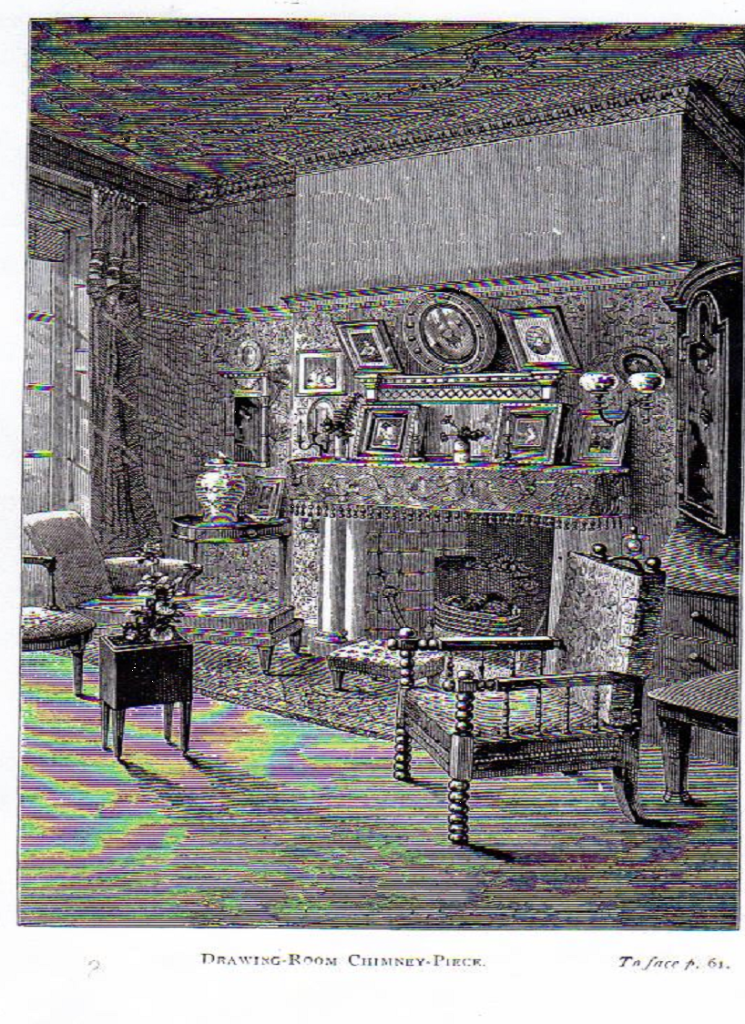
Rhoda died in 1882, but Agnes carried on the business of ‘R & A Garrett’, house decorators, until 1905, although in 1899 the lease on the firm’s warehouse in Morwell Street came to an end, necessitating the sale of its contents and, presumably, a reduction in the work undertaken. Incidentally the Morwell Street building and its neighbours has recently, 2022, been approved for demolition, to be replaced by a 6-storey building. When I first noted it c 2000, the Garrett’s ‘warehouse’ retained its original façade (illustrated in Enterprising Women), which has subsequently been altered – now another Garrett link will be utterly obliterated. However, that furniture sale, held at Phillips, Son and Neale on 27 July 1899, has provided me with considerable scope for research – allowing me to identify a number of individuals keen to buy furniture and house accoutrements that had the Garrett seal of approval – in that they had passed through Agnes’ hands – and to muse a little on the state of the ‘house furnishing’ market at the end of the 19th century. That research will appear in a subsequent post on this website.
Copyright
All the articles on Woman and Her Sphere are my copyright. An article may not be reproduced in any medium without my permission and full acknowledgement. You are welcome to cite or quote from an article provided you give full acknowledgement
The Garretts And Their Circle: A Talk on Fanny Wilkinson
Posted by womanandhersphere in The Garretts and their Circle on May 12, 2020
Lock-Down Reviews: The Lives And Work Of Two Garrett Cousins: ‘Endell Street’ and ‘Margery Spring Rice’
Posted by womanandhersphere in Lock-Down Research, The Garretts and their Circle on May 6, 2020
Serendipitously, lock-down has given me the opportunity of making closer acquaintance with two cousins, products of that ever-interesting family – the Garretts.
Louisa Garrett Anderson and Margery Spring Rice, members of the generation that came after the pioneering Garrett sisters Elizabeth, Millicent and Agnes, are each the central figure in new books spotlighting aspects of ‘women’s work’ that, although not forgotten, have hitherto not received detailed attention. The books differ in concept in that one is a study of an enterprise and the other is a straight biography, but central to both is evidence of a steely Garrett determination.
Endell Street by Wendy Moore is a study of the military hospital opened in London during the First World War by Dr Louisa Garrett Anderson and her companion, Dr Flora Murray. The hospital was exceptional in that it was the first in which women doctors were able to treat male patients. In fact, the entire staff (with the exception of a few orderlies) consisted entirely of women. Although Dr Murray recounted the work of the hospital in Women as Army Surgeons, published in the immediate aftermath of the war, it is certainly time, a hundred years later, to look at it with fresh eyes.
Louisa Garrett Anderson (1873-1943), daughter of Britain’s pioneer doctor, Elizabeth Garrett, and Flora Murray (1869-1923), daughter of a retired Scottish naval commander, had both studied at the London School of Medicine for Women, with Murray finalising her degree at Durham University. At the turn of the 20th century women doctors still faced considerable difficulty in advancing their careers and Garrett Anderson and Murray, denied positions in general hospitals, were restricted to treating women and children. The professional difficulties with which they had to contend forced them away from the constitutional suffrage movement, led by Louisa’s aunt Millicent, and into Mrs Pankhurst’s militant WSPU. Garrett Anderson even spent time in prison after taking part in a 1912 protest.
Medal issued by the Women’s Hospital Corps. For sale 0 see item 512 in my Catalogue 202 Part 2
The outbreak of war in August 1914 offered an opportunity to escape the medical cage, an opportunity seized by Garrett Anderson and Murray with both hands. Their offer to help in the war effort having been repudiated by the authorities, they struck out on their own. travelling to France in September 1914 to tend wounded soldiers in hospitals they set up themselves, first in Paris and then in Wimereux. They named their outfit the Women’s Hospital Corps and It was the success of these first, small, French-based operations that led them in 1915 to be invited by the War Office to run a military hospital in London. They opened it in an old workhouse in Endell Street, Covent Garden, convenient for the trains bringing the wounded back from France. All involved with the Endell Street hospital were aware that they were operating on sufferance and that any lapse of standards would damage the professional chances of future women doctors
The author has researched diligently, enlisting the aid of diaries, letters and family memories of both staff and patients to paint a more inclusive picture of the hospital and its occupants than that depicted by Dr Murray. These reveal how demanding the work was of all the women. Stretcher bearers and surgeons alike tackled situations they had never previously encountered. Louisa Garrett Anderson was the hospital’s main surgeon and Flora Murray its anaesthetist. Obviously neither they, nor the other women doctors on the staff, had any previous experience of the types of wounds – and patients – they were now treating, but proved very competent in developing the necessary skills. From mid-1916 the hospital trialled the use of a new antiseptic paste, known as BIPP, which proved very successful when used on men sent back to them from the Somme battlefield.
As neither Garrett Anderson nor Murray left direct descendants or private papers it is difficult to get close to them. The image they presented is the one that survives and suggests that both were reserved, with Murray the more resolutely aloof and Garrett Anderson slightly more approachable. These characteristics, while perhaps natural, were also necessary in giving the women the credibility with which to operate such an establishment. Yet it is clear they were greatly appreciated by both staff and patients. Endell Street appears to have been comfortable and sociable, the male patients soon becoming entirely at ease with the idea of being treated by women.
Although it is perhaps difficult to bring the principals to life, Endell Street is characterised by the more personal stories of young women who, travelling from all parts of Britain, Australia, Canada and the US, had the foresight to record their experiences. These are enlivened by the revelations of all-too-human work-centred discontents. The novelists Beatrice Harraden and Elizabeth Robins clearly managed to wring a good deal of drama out of running the hospital library.
Endell Street was decommissioned in the autumn of 1919. During its final year the hospital treated victims of the three waves of the ‘flu pandemic, in February 1919 experiencing more deaths than it had in any month during the war. These deaths included a significant number of staff members.
But, as the author comments, as far as women in medicine were concerned, ‘The war had changed everything, and nothing’. After the war, while some professions were opened up to women for the first time, it was once again made very difficult for women doctors to build a hospital career and young women were again barred from many medical schools. Sadly, after a brief effort, Murray and Garrett Anderson were unable to continue running the hospital for children that they had founded before the war. In the final chapter the author assuages our curiosity and details the ‘afterlives’ of Garrett Anderson and the other women with whom we’ve kept company during the war years in Endell Street.
In the summer of 2017 I very much enjoyed taking part in a a performance of ‘Deeds Not Words’, an immersive drama staged by Digital Drama in the Swiss Church in Endell Street, opposite the site of the hospital. Belief was suspended, and I really felt myself walking through the hospital wards, encountering staff and patients. You can watch a Digital Drama film about the Endell Street hospital here. This is based on some of the material used by Wendy Moore in Endell Street.
See also a post on this website Women and the First World War: the work of women doctors
Apparently Louisa Garrett Anderson’s one venture into print, a biography of her mother, was prompted by learning that a cousin, Margery Spring Rice (1887-1970), was considering Elizabeth Garrett Anderson as a suitable subject for just such a work. Now Margery, in her turn, has had her life placed under the spotlight- by Lucy Pollard, a grand-daughter. And what a rewarding subject she is. Here all is drama – love, death, affairs, court cases, divorce, blighted lives – set alongside the achievements of a life spent working to improve the lot of working-class women.
Margery Garrett was the daughter of Sam Garrett, a favourite brother of Elizabeth and Millicent. He seems to have been easy going; his daughter was rather more volatile. She was educated at Girton, married in 1911 and had three children before her husband was killed on the Somme in 1916. A disastrous second marriage produced two more children. Equipped with an abundance of energy Margery Spring Rice, as she now was, chanced on the cause of birth control as the subject of her life’s work. This was a subject shunned by the medical profession but one which she recognised as an imperative if poor women were to retain their health and any ability to care properly for the children they did bear.
In 1924, with two friends, she founded a ‘contraception clinic’ in north Kensington, a notoriously impoverished area, retiring only in 1957. It proved very successful with Margery ‘wholeheartedly encouraging and supporting the liberal attitude prevalent among its staff’. In 1939 she wrote Working-Class Wives: their health and conditions (Penguin) which has become a classic, re-published by Virago in 1981.
Margery Spring Rice is a delight to read. Well-written and impeccably referenced, this is no hagiography, Lucy Pollard making clear that Margery Spring Rice was a difficult woman ‘not much given to self-reflection or self-doubt’, ‘full of contradictions’, and, to my mind, all the more interesting for it. She spent much of her life in Suffolk and for a time was close to Benjamin Britten, although, rather poignantly did find herself dropped in later years. I love the cover illustration showing ‘Margery pushing a young friend along the Crag Path in Aldeburgh, New Year 1968’ (Christopher Ellis).
Wendy Moore, Endell Street: the trailblazing women who ran World War One’s most remarkable military hospital, Atlantic Books, 2020, £17.99.
Lucy Pollard, Margery Spring Rice: pioneer of women’s health in the early twentieth century, Open Books Publishers, 2020.
Free download: https://www.openbookpublishers.com//download/book/1204
Hardback: £29.95
Paperback: £19.95
For full details see here
Copyright
The Garretts And Their Circle: Fanny Wilkinson And Middlethorpe Hall
Posted by womanandhersphere in The Garretts and their Circle on July 9, 2018
Middlethorpe Hall, York
As part of Bloom! – a festival celebrating horticulture and flowers in York – I was invited give a talk yesterday about Fanny Wilkinson, Britain’s first professional woman landscape gardener, in Middlethorpe Hall, the home of her youth.
Middlethorpe Hall, now owned by the National Trust and run by the Historic House Hotels, is utterly lovely – from its panelled interiors, delicious food, kind staff – to its interesting and well-kept – and extensive – grounds. It retains an appealingly domestic atmosphere and it wasn’t difficult to think of Fanny Wilkinson living there in the 1880s with her mother and sisters.
Yet Fanny was not content with being a ‘daughter-at-home’ and enjoying these beautiful surroundings (although letters show she was delighted to return to Middlethorpe for short breaks) and it was while living here that she developed the ambition of becoming a landscape gardener. Wasting no time, she set off for London and enrolled at the Crystal Palace School of Gardening, run by Edward Milner who had been a pupil of Joseph Paxton. She was the only woman student- and an upper-middle class woman at that. All the others were male artisans – for whom the School was intended.
If you are interested in discovering just how many of London’s open spaces were designed by this one determined woman, you can read all about Fanny Wilkinson’s extremely successful career – and discover how it was intertwined with those of Elizabeth Garrett Anderson, Millicent Fawcett and Agnes Garrett, in Enterprising Women:the Garretts and their circle see https://francisboutle.co.uk/products/enterprising-women/
Copyright
The Garretts And Their Circle: What Should The Practical Medical Student Wear?
Posted by womanandhersphere in The Garretts and their Circle on January 7, 2018
Millais: ‘Trust Me’
As she embarked on her novel medical career Elizabeth Garrett gave some thought as to how she should dress. In September 1860, while working as a nurse at the Middlesex Hospital, she wrote to Emily Davies:
‘Experience is modifying my notions about the most suitable style of dress for me to wear at the hospital. I feel confident now that one is helped rather than hindered by being as much like a lady as lies in one’s power. When my student life begins, I shall try to get very serviceable, rich, whole-coloured dressed that will do without trimmings and not require renewing often.’
Three years later, still trying to piece together her medical training, she spent the autumn of 1863 fulfilling the ‘clinical practice’ requirement for the London Society of Apothecaries’ qualification, by attending clinics at the London Dispensary in Spitalfields. As Jo Manton writes in her biography of Elizabeth, the London Dispensary was ‘charity at its bleakest’, 2000 outpatients from the surrounding slums passing through its doors each year. Thanks to the following brief comment in a letter to Harriet Cook, 23 December 1863, we, too, can picture Elizabeth Garrett as she travelled through sordid Whitechapel from her lodgings at 8 Philpot Street and then helped to treat patients in the Dispensary at 21 Church Street, Spitalfields (now 27 Fournier Street). Had she seen the Millais painting and thought ‘That is just the effect a tyro female doctor must create’?
’ I think your critical eyes would be satisfied if they could see me in my working dress. I was fortunate enough to find a delightful gown of bright pre-Raphaelite brown which has stood 9 weeks of hard and constant wear without losing its colour or freshness of look. So you can fancy me in it. The colour resembles that in Millais’ “Trust Me” tho’ the material is less magnificent than that was.’
27 Fournier Street, Spitalfields, formerly the London Dispensary
Copyright
The Garretts And Their Circle: A Talk At The Royal Society of Medicine To Celebrate The 150th Anniversary of Elizabeth Garrett’s Qualification As A Doctor
Posted by womanandhersphere in The Garretts and their Circle on January 19, 2016
On 28 September 1865 Elizabeth Garrett succeded in qualifying as a doctor and as such is hailed as the first woman in Britain to do so. That is, she was first woman qua woman (ie not, as Miranda Barry, in the guise of a man) and she was the first woman to gain British medical qualifications (ie not, as her mentor Elizabeth Blackwell, by qualifying in the US).
To celebrate this auspicious event I was asked, along with Professor Neil McIntyre, to gave a talk at the Royal Society of Medicine. That there is still a great deal of interest in Elizabeth Garrett and her fellow pioneers was evident as we surveyed the packed house.
The video of my talk, Elizabeth Garrett Anderson and her Hospital, is now available to view here. Professor McIntyre’s talk, Elizabeth Garrett Anderson and her Medical Schools, can be viewed here.
For those interested in learning more about Elizabeth Garrett’s medical career do visit the ‘Elizabeth Garrett Anderson Gallery at the UNISON Centre – for more details see here.
You might also be interested in reading my book – Enterprising Women: the Garretts and their circle – for details see here.
Copyright
Caroline Crommelin and Florence Goring Thomas: 19thc Interior Decorators: Who Were They?
Posted by womanandhersphere in The Garretts and their Circle, Uncategorized on May 26, 2015
Caroline Anna de Cherois Crommelin (c 1854-1910) was born in Co Down, Ireland, one of the many children of Samuel de la Cherois Crommelin of Carrowdore Castle.
Although of gentle birth, the family had little money. Political unrest in Ulster forced a move to England and after their father’s death in 1885 Caroline Crommelin and her sisters found it necessary to work to support themselves.
Caroline’s elder sister, May, became a novelist and enjoyed a measure of popular success. In 1903 another sister, Constance, married John Masefield (who was very much her junior).
In 1886 another of the sisters, Florence, married a solicitor, Rhys Goring Thomas, and in the late 1880s with Caroline, who seems to have been the driving force, embarked on a career as a ‘lady decorator’. The pair were able to travel easily along the path blazed for them a decade earlier by Rhoda and Agnes Garrett.
Unlike the Garretts, Caroline and Florence do not appear to have had any specific training, although years later Caroline wrote that an apprenticeship was essential. Rather, they relied on what was assumed to be a natural taste absorbed from their early surroundings. In a later interview Caroline described how their father had given the two of them a room in Carrowdore Castle to do with as they wished and from painting and papering this room they had learned their trade. Whereas Rhoda and Agnes Garrett were happy to deal with drains and internal structures, I doubt that such practicalities fell within the Crommelin sisters’ remit.
It was ‘beautifying’ that was the word most often used to describe Caroline Crommelin’s work. An article by Mary Frances Billington in The Woman’s World, 1890, describes how in 1888 Caroline Crommelin set up a depot at 12 Buckingham Palace Road for the ‘sale of distressed Irish ladies’ work’ and then ‘saw a wider market as a house-decorator, so she wrote ‘Art at Home’ on her door-plate, took into partnership her sister, Mrs Goring Thomas..and boldly set forth to hunt for old oak, rare Chippendale, beautiful Sheraton and Louis Seize furniture’. She attended auctions in all parts of the country and, in case there was any doubt as to the propriety of this involvement with trade, reported that she had no difficulty doing business with dealers, meeting only with civility.
Noting the popularity of old, carved oak, the sisters’ bought old plain oak pieces and then had them carved by their own craftsmen. There was always a stock of such pieces in their showroom.
The ‘Arts at Home Premises’ were opened in Victoria Street, London, in early 1891. I think their house was at 167a Victoria Street – certainly by 1898 this was Caroline Crommelin’s work premises, but it’s possible that in the late 1880s she was working from 143 Victoria Street. Of the ‘Arts at Home’ premises The Sheffield Telegraph (9 March 1891) described how’charmingly arranged rooms, stored with delightful old oak, Sheraton, and Chippendale furniture, quaint brass ornaments, old silver, beautiful tapestries, and old china were crowded all afternoon with the many friends of the clever hostesses.’..The oak room featured a delightful ‘cosy corner’ in dark oak with blue china arranged on the top ledge against the pink walls. May Billington’s article includes a line-drawing of a corner of the ‘Arts at Home’ showroom.
In its 23 November 1895 issue the York Herald commented of Caroline Crommelin that ‘Her house in Victoria St is conspicuous to the passer by for the pretty arrangement of its curtains, and inside the artistic element is even more apparent. Miss Crommelin has been very successful as a house beautifier and her opinion has been much sought after and esteemed by those who like the home to be dainty and harmonious.’
In 1891 the sisters also displayed their wares at the Women’s Handicrafts Exhibition at Westminster Town Hall. The Manchester Times singled them (‘two of our cleverest art decorators’) out for praise. ‘These ladies have shown that… old oak furniture need not be gloomy and dusty and that new furniture may be made to look as good as old, even if the old be Chippendale or Sheraton, Queen Anne or Dutch marqueterie.’
One of Caroline Crommelin’s first ‘beautifying’ commissions was carried out for Lord and Lady Dufferin on the British Embassy in Rome in 1890/1891. The Manchester Guardian (8 Oct 1889) reported that she redecorated the entire embassy. Doubtless this plum commission was not unconnected to the fact that the Dufferin estate in Co Down was a mere 10 miles from Carrowdore Castle; the families were presumably known to each other. Rather more surprising is the claim made in an interview with her in the Women’s Penny Paper, 23 Nov 1889, that she had ‘supplied nearly all the furniture to Lord Cholmondeley’s old place at Houton [sic]. Houghton Hall was let to tenants during the 19th century so, perhaps, there is a kernel of truth buried in this statement – but I don’t think we need go looking at Houghton as it is today for evidence of Caroline Crommelin’s involvement in its decoration.
In interviews Caroline Crommelin also made clear that she ‘undertakes, when required, to furnish a whole or any part of a house, either going with the customer to different firms or selecting for them’ and ‘does not confine herself to decorative work alone, and will put up blinds or attend to the whitewashing of a ceiling with the most professional alacrity’.
Both Caroline and Florence were supporters of the campaign to give the vote to women householders and were keen to see women’s advancements in the professions – particularly as architects.
In 1895 Caroline Crommelin married Robert Barton Shaw, nephew of a former Recorder of Dublin, who in the 1901 census return is described as an estate agent. I wonder if his wife helped in ‘beautifying’ houses he had for sale? In 1901 they were living at 50 Morpeth Mansions, Morpeth Terrace. Caroline in this census return is described as an ’employer’. Florence lived close by -in 1891 at 3 Morpeth Terrace. However hers was to be a short-lived career – she died in 1895, aged only 37, a few months before her sister’s marriage. In the 1889 Penny Paper interview Florence was quoted as saying ‘I believe everybody is happier for working. It carries one into a new life, and one does not have time to think of being ill’. In the light of her early death this has a certain poignancy, suggesting she may have had a chronic illness to overcome.
Caroline carried on the business on her own and in 1903 teamed up with her sister, May, to write a chapter on ‘Furniture and Decoration’ in Some Arts and Crafts (ed Ethel Mckenna), published in The Woman’s Library series by Chapman & Hall. In this they ran through the various periods of furniture and room design but did not bother to disguise their support for one style in particular. ‘Anyone of artistic feeling is sensible of a singular sense of well-being on entering a genuine Queen Anne sitting-room. If analysed, the sensation will be found to arise from an instantaneous inner perception that all is in just proportion. The height and size of the room obey accurate laws. Its ceiling is relieved by geometrical designs. The walls are half-wainscoted; the polished floor shows up the tapestry-like carpet in the centre. The ornaments of furniture and general decoration are neither profuse, grotesque, nor severe. In all, the fatal “too much” is avoided.’
Caroline Crommelin (or, rather, Mrs Barton Shaw) died at 18 Albion Place, Ramsgate on 1 February 1910.
Copyright
Mrs Hartley Brown And Miss Townshend -19th-c Interior Decorators: Who Were They?
Posted by womanandhersphere in The Garretts and their Circle on February 27, 2015
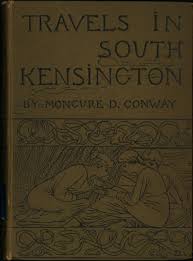 In a chapter on ‘Decorative Art in England (Travels in South Kensington, 1882) Moncure Conway commended Rhoda and Agnes Garrett for their ‘admirable treatment of the new female colleges connected with English Universities’. It has always been a niggle that neither I – or anyone else – as far as I know – has ever been able to find any evidence that the Garretts did work on the interior of any women’s college.
In a chapter on ‘Decorative Art in England (Travels in South Kensington, 1882) Moncure Conway commended Rhoda and Agnes Garrett for their ‘admirable treatment of the new female colleges connected with English Universities’. It has always been a niggle that neither I – or anyone else – as far as I know – has ever been able to find any evidence that the Garretts did work on the interior of any women’s college.
As one member of the Garrett family, Elizabeth, was a close friend and supporter of Emily Davies, founder of Girton, another, Millicent, was a founder of Newnham, and Rhoda and Agnes had received their training in the office of J.M. Brydon, sharing an office with Newnham’s architect, Basil Champneys, it would not have been at all surprising if they had been involved with the interior decoration of one or other of the colleges. But neither in Garrett family letters nor in the press is there any mention of Rhoda and Agnes working on the interior of Newnham – or of Girton.
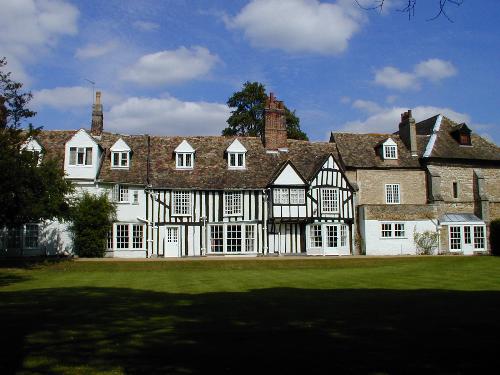 Merton Hall, Cambridge. (Photo courtesy of Cambridge 2000)
Merton Hall, Cambridge. (Photo courtesy of Cambridge 2000)In fact the only mention of work being done by women interior decorators on a Cambridge women’s college relates to furnishings for an early incarnation of Newnham – when, between October 1871 and 1874, it was housed in an ancient, rambling house, Merton Hall. The house belonged (and still belongs) to St John’s College, whose Master was very sympathetic to the Lectures for Ladies’ scheme that had been instigated in Cambridge by Millicent Fawcett, Henry Sidgwick and Jemima Anne Clough.
Merton Hall is first mentioned by Moncure Conway in ‘Decorative Art and Architecture in England’, an article published in Harpers New Monthly Magazine, November 1874. In this, after discussing the work of Rhoda and Agnes Garrett, he tells us that Mrs Hartley Brown and Miss Townshend had set up in the same business as the Garretts, in premises at 12 Bulstrode Street. He then goes on to say that ‘These ladies, who have been employed to decorate the new ladies’ College (Merton) at Cambridge, have not only devised new stuffs for chairs, sofas and wall panels, but also for ladies’ dresses.’ The fact that he uses the past tense seems to indicate that the work was already complete.
A further allusion to this partnership is made by Emily Faithfull when discussing new trade opportunities that have been opening for women. In Three Visits to America (1884) she mentions that ‘Mrs Hartley Brown and Miss Townshend, soon after entering into partnership, were appropriately employed in decorating Merton College, and devised with much success some new stuffs for the chairs and sofas for the use of Cambridge girl graduates.’
That seems quite clear: Mrs Hartley Brown and Miss Townshend had been involved with furnishing Merton Hall (later Newnham) and neither Conway or Faithfull, although discussing the Garretts’ work, made any mention of the Garrtts being similarly employed.
However, when Moncure Conway came to publish Travels in South Kensington in 1882 the Garretts were going from strength to strength and, if the silence in the press is anything to go by, Mrs Hartley Brown and Miss Townshend had gone out of business. One construction might be that, while making no mention of the latter two, Conway lauds the success of the Garretts and, carelessly assigns to them the ‘admirable treatment of female Colleges’. It may be that only one firm of female interior decorators worked on the furnishings of a female college – and that was the partnership of Mrs Hartley Brown and Miss Townshend.
But who were Mrs Hartley Brown and Miss Townshend? I have to confess to drawing a blank on Mrs Hartley Brown – but can make an educated guess at the identity of Miss Townshend.
In his Harper’s 1874 article Conway (who, as we see was prone to getting things a bit muddled) mistakenly describes Mrs Hartley Brown as ‘a sister of Chambray Brown, Esq – a very distinguished architect’. In fact what he meant was that ‘Miss Townshend was a sister of Chambray Townshend…’. The latter was indeed an architect, although not even his wife – indeed particularly not his wife – would have called him distinguished. Unfortunately for us Chambray Townshend had eight sisters. And the question is ‘which one went into business as an interior decorator?’
Well three can be discounted, being in 1874 already married. Of the remaining five, very little is known of the lives of three, although Alicia, who didn’t marry until 1880, is known to have studied art at the Slade and is I suppose a possibility. However I suspect that the two strongest candidates of the five are Isabella (1847-1882) and Anne (1842-1929).
Anne certainly seems to have the most productive work record. According to family information she trained as a nurse at London’s Foundling Hospital and was later Matron at the Hospital for Hip Disease in Childhood (Queen’s Square). When and for how long she was engaged in nursing I don’t know. By 1882 she had moved into philanthropic administration and was secretary of the Metropolitan Association for Befriending Young Servants (MABYs).
Then in 1888 she became the first secretary of the Ladies’ Residential Chambers Co (the founders of which included Agnes Garrett and Millicent Fawcett) and remained involved with the company until 1910. In 1890, when the company was planning a new set of chambers in York Street, Marylebone, it was Anne Townshend who was deputed to consult with Thackeray Turner, the architect, over the company’s specifications for the new building. However nowhere in the minutes of the Ladies’ Residential Co is there any suggestion that she was ever involved with the interior design of either of the buildings.
Isabella Townshend is the more artistic candidate – and she does have a very clear Cambridge connection- being one of the Girton Pioneers. In 1869 she was one of the first five to join Emily Davies at her new college at Hitchin (it was not yet ‘Girton’). She left without taking a Tripos at Easter 1872. Could she then have gone into the interior decorating business?
In Girton College, Barbara Stephen comments that ‘Miss Townshend was not striking in either appearance or manner‘, while reporting Barbara Bodichon’s opinion that [Isabella’s] ‘interests were wide and her mind original’ Barbara Stephen was too young ever to have met Isabella; perhaps she made her rather harsh judgement on the basis of this photograph she included in her book
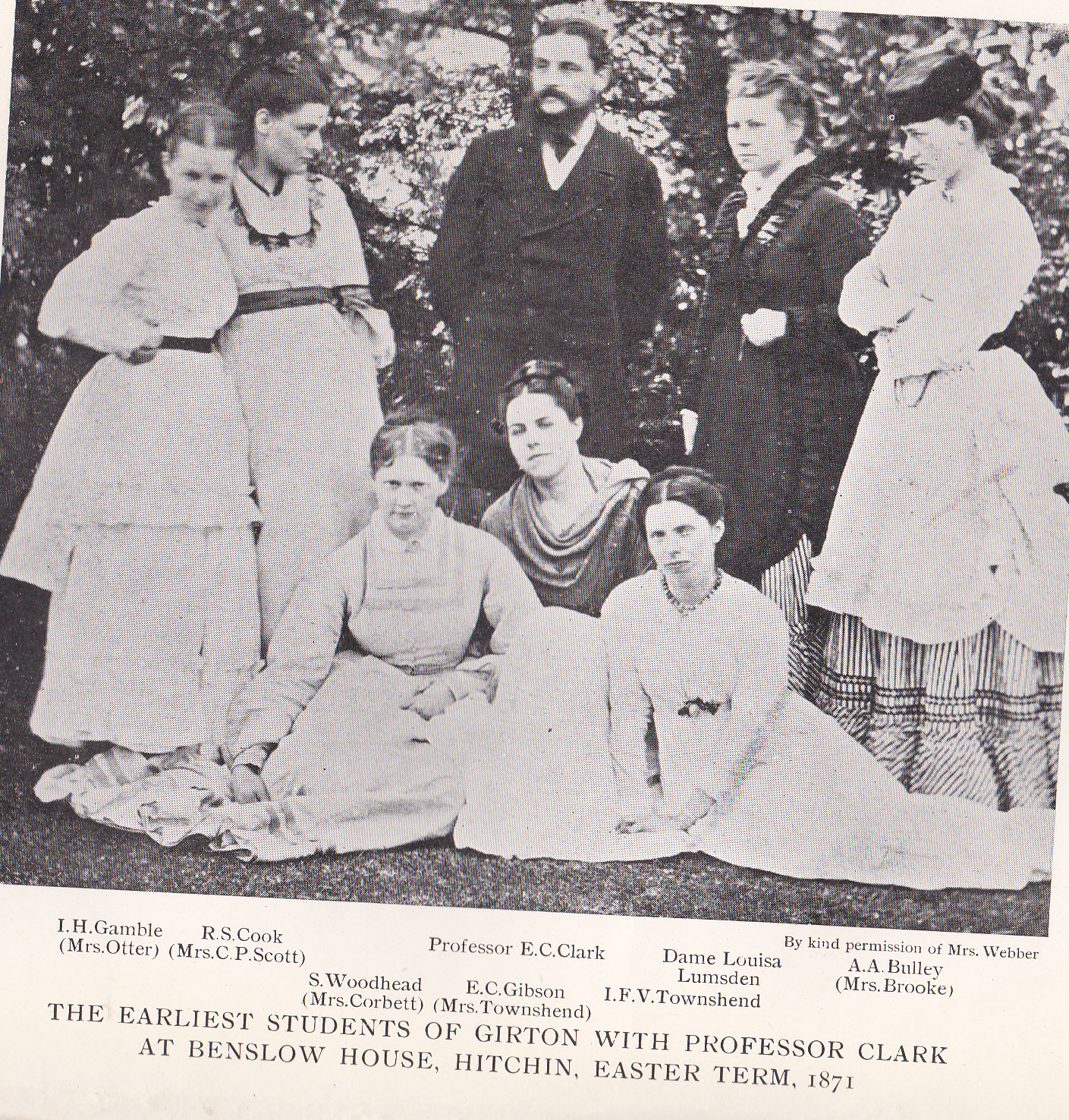 However, Isabella certainly made a very strong impression on her fellow Pioneers – particularly on Emily Gibson. When Isabella left Hitchin in the 1872 without taking a Tripos (perhaps it was this high-handed approach to all that Miss Davies had to offer that attracted Barbara Stephen’s disapproval) Emily followed suit and the following year married Isabella’s brother, Chambray Townshend.
However, Isabella certainly made a very strong impression on her fellow Pioneers – particularly on Emily Gibson. When Isabella left Hitchin in the 1872 without taking a Tripos (perhaps it was this high-handed approach to all that Miss Davies had to offer that attracted Barbara Stephen’s disapproval) Emily followed suit and the following year married Isabella’s brother, Chambray Townshend.
In Some Memories for Her Friends., Emily wrote of Isabella: ‘She was more mature than many of us, and in quite a different stage of development, but the sort of position she held among us, the sort of influence she exercised over me was chiefly due to her having been swept over by a very early wave of that current of aestheticism which was then just beginning to gather force. The sort of doctrine she taught, or rather that she gave living expression to, was, that the most valuable means of culture was to be found in the enjoyment of the beautiful in nature and art, that a beautiful combination of colours, a delicate bit of decorative work seen and cared for in a reverent and appreciative spirit, could do more for us in the way of training and development than much steady grinding away at mathematics and classics.’
‘She had considerable ability, indeed, many of us gave her credit for a touch of genius, yet she never accomplished much definite work of any kind.’..Isabel took the utmost pains to live from hand to mouth. She would work hard now and again when she felt the subject in hand to be worth working at, but she scorned to tie herself down to do things against inclination for the sake of obtaining some definite mundane good.’
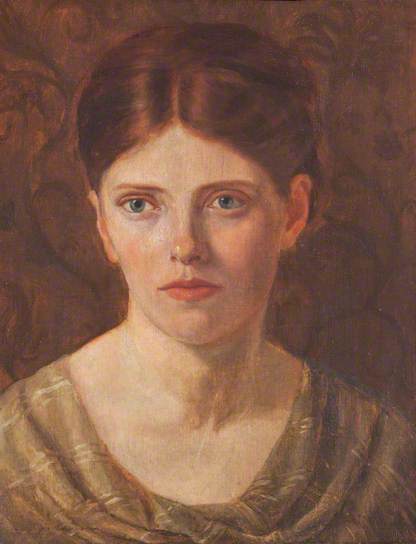 Isabella Townshend, self-portrait, (c) Girton College, University of Cambridge. Supplied by The Public Catalogue Foundation
Isabella Townshend, self-portrait, (c) Girton College, University of Cambridge. Supplied by The Public Catalogue FoundationIsabella Townshend was undoubtedly ‘artistic’. Isn’t this a wonderful self-portrait – bequeathed to Girton by Emily Townshend? It wouldn’t at all surprise me if Isabella had not ‘devised new stuff’ for her dress and designed it herself. But did she have the stamina to set up in business? Emily Gibson mentions that in the period between leaving Cambridge and her marriage to Chambray Townshend, he and Isabella were particularly friendly with Walter and Lucy Crane – so she was certainly moving in art design circles.
There is no doubt that interior decorating ran in the family veins. In his Harper’s article Moncure Conway wrote ‘I have become convinced by a visit to a beautiful house which Chambrey Townshend arranged at Wimbledon, that there can be nothing so suitable for somewhat dark corridors and staircases as a faint rose tint. In Mr Townshend’s house, however cold and cheerless the day may be, there is always a glow of morning light. This gentleman has shown that a sage-gray paper with simple small squares (such as Messrs Marshall & Morris make) furnishes a good dado to support the light tints upon walls not papered.’
The house may well have been the Townshend family home at 12 Ridgway Place, Wimbledon, where the unmarried sisters lived with their mother.
Unfortunately Chambray Townshend took the same laissez-faire approach to work as did Isabella. Of him Emily, his wife, later wrote ‘Chambrey Townshend had little push and no business ability to back up his remarkable artistic abilities.’ After his death she regretted she hadn’t devised some opening for his remarkable talent for house decoration ‘when architectural work was not forthcoming’.
If the interior decoration business was run by Mrs Hartley Brown and Isabella Townshend, it may be that Isabella soon lost interest. In the early 1880s she went to Italy to study painting and died in 1882. The Girton Register has it that she died in Italy, ‘of typhoid fever contracted at Capri’. It may well be that she became ill in Italy, but the Probate Register shows that she died on 20 July 1882 at Ealing and was buried at Perivale on 25 July 1882.
So, although Anne Townsend had the stamina and application to run a business, I’m inclined to think that it was Isabella Townshend who, for a brief period, was in partnership as an interior decorator with Mrs Hartley Brown and who provided the furnishings for Merton Hall, the early incarnation of Newnham.
For more about the interior decoration business run by Rhoda and Agnes Garrett see here.
**
The Garretts And Their Circle: Annie Swynnerton’s ‘Crossing The Stream’
Posted by womanandhersphere in The Garretts and their Circle on July 24, 2013

‘Crossing the Stream’ by Annie Swynnerton. Manchester City Art Gallery Collection. Photo courtesy of MCAG and ArtUK
Another of Annie Swynnerton’s paintings left to Manchester City Art Gallery by Louisa Garrett.
The way in which the Garrett circle did their best to ensure that Annie Swynnerton’s work was included in major public collections is discussed in my book – Enterprising Women: the Garretts and their circle- available online from me, or Francis Boutle Publishers or from all good bookshops.
The Garretts And Their Circle: Annie Swynnerton’s ‘The Town of Siena’
Posted by womanandhersphere in The Garretts and their Circle on July 23, 2013

‘The Town of Siena’ by Annie Swynnerton, Manchester City Art Gallery Collection, photo courtesy of MCAG, BBC Your Paintings and ArtUK
This is another of Annie Swynnerton’s paintings left to Manchester City Art Gallery by Louisa Garrett.
The way in which the Garrett circle did their best to ensure that Annie Swynnerton’s work was included in major public collections is discussed in my book – Enterprising Women: the Garretts and their circle- available online from me, or Francis Boutle Publishers or from all good bookshops..
The Garretts And Their Circle: Annie Swynnerton’s ‘Illusions’
Posted by womanandhersphere in The Garretts and their Circle on July 22, 2013

‘Illusions’ by Annie Swynnerton, Collection Manchester City Galleries, courtesy of BBC Your Paintings & ArtUK
This painting was left to the City Art Gallery, Manchester, by Louisa Garrett (nee Wilkinson, sister-in-law to Elizabeth Garrett Anderson, Millicent Fawcett and Agnes Garrett.
‘Illusions’ would once have hung in Louisa’s home at Snape in Suffolk. Her house was named ‘Greenheys’ after the area of Manchester in which she and her sister, Fanny, grew up.
The way in which the Garrett circle did their best to ensure that Annie Swynnerton’s work was included in major public collections is discussed in my book – Enterprising Women: the Garretts and their circle- available online from me, or Francis Boutle Publishers or from all good bookshops..
The Garretts and Their Circle: Annie Swynnerton’s ‘The Dreamer’
Posted by womanandhersphere in The Garretts and their Circle on July 19, 2013
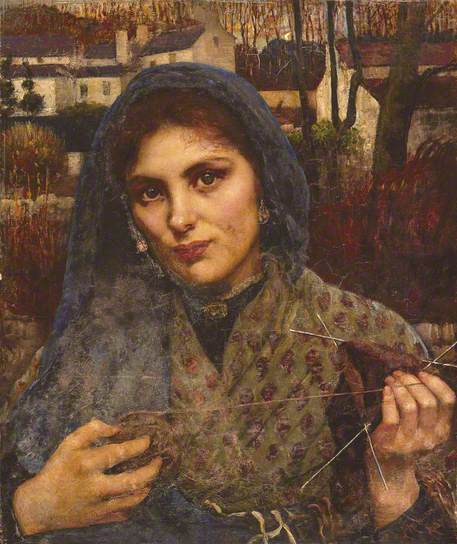
The Dreamer by Annie Swynnerton, 1887. (c) Manchester City Gallery – image courtesy of BBC Paintings and ArtUK
In yesterday’s post I drew attention to Annie Swynnerton’s portrait of Millicent Fawcett. It was hardly chance that brought that artist and that sitter together; both were central figures in what I term ‘the Garrett circle’.
Today’s painting by Annie Swynnerton, The Dreamer, was originally owned by Millicent Fawcett’s sister-in-law, Louisa Garrett (nee Wilkinson) who for a while lived next-door-but-one to Millicent Fawcett and Agnes Garrett in Gower Street (the latter at no 2 and the Wilkinsons at no 6). The Dreamer was owned jointly by Louisa and her sister, Fanny, and may for a time have graced the walls of 6 Gower Street. Louisa only moved out of no 6 on her marriage to Millicent and Agnes’ youngest brother, George Garrett.
Fanny Wilkinson and Louisa Garrett did all in their power to ensure that, after their deaths, Annie Swynnerton was represented in public collections. In her will Louisa specifically left her share in this painting to Fanny and expressed ‘the desire that she will bequeath the said picture to the City Art Gallery, Manchester.’
Discover much more about the way in which the Garrett circle did their best to ensure Annie Swynnerton’s continuing reputation in my Enterprising Women: the Garretts and their circle- available online from me, or Francis Boutle Publishers or from all good bookshops..
Elizabeth Garrett Anderson Gallery At The UNISON Centre
Posted by womanandhersphere in The Garretts and their Circle on March 28, 2013
ALAS, IT WOULD APPEAR THAT THE GALLERY HAS FAILED TO REOPEN AFTER COVID CLOSURE. PLEASE PHONE UNISON TO ENQUIRE.
The Elizabeth Garrett Anderson Gallery at the UNISON Centre tells the story of Elizabeth Garrett Anderson, of the hospital she built, and of women’s struggle to achieve equality in the field of medicine.
Elizabeth Garrett Anderson (1836-1917) was determined to do something worthwhile with her life. In 1865 she qualified as a doctor. This was a landmark achievement. She was the first woman to overcome the obstacles created by the medical establishment to ensure it remained the preserve of men.
Elizabeth Garrett Anderson then helped other women into the medical profession, founding the New Hospital for Women where women patients were treated only by women doctors.
Elizabeth Garrett Anderson, by her example, demonstrated that a woman could be a wife and mother as well as having a professional career.
Elizabeth Garrett Anderson worked to achieve equality for women, being especially active in the campaigns for higher education and ‘votes for women’.
In the early 1890s the New Hospital for Women (later renamed the Elizabeth Garrett Anderson Hospital) was built on the Euston Road and continued to treat women until 2000. For some years this building then lay derelict until a campaign by ‘EGA for Women’ won it listed status. UNISON has now carefully restored the building, bringing it back to life as part of the UNISON Centre.
Two important rooms in the original 1890 hospital building have been dedicated to the Elizabeth Garrett Anderson Gallery. One is the
ORIGINAL ENTRANCE HALL
of the hospital which has been carefully restored to its original form. Here you can study an album, compiled specially for the Gallery, telling the history of the Elizabeth Garrett Anderson Hospital in words and pictures, while, in the background you can listen to a soundscape evocative of hospital life. This is interwoven with the reminiscences of hospital patients, snippets from the letters of Elizabeth Garrett Anderson and sundry other sounds to stimulate your imagination.
The other Gallery room is what was known when the hospital opened as
THE MEDICAL INSTITUTE
This was a room, running along the front of the hospital, parallel to Euston Road, set aside for all women doctors, from all over the country, at a time when they were still barred from the British Medical Association. It was intended as a space in which they could meet, talk and keep up with the medical journals.
Here you can use a variety of media to follow the story of women, work and co-operation in the 19th and 20th centuries.
A BACK-LIT GRAPHIC LECTERN RUNS AROUND THE MAIN GALLERY:
allowing you to see in words and pictures a quick overview of the life of Elizabeth Garrett Anderson and of her hospital.
AT INTERVALS ARE SET SIX INTERACTIVE TOUCH-SCREEN MONITORS
-named – Ambition, Perseverance, Leadership, Equality, Power in Numbers and Making Our Voices Heard – allowing you to access more information about Elizabeth Garrett Anderson, about the social and political conditions that have shaped her world and ours, and about the building’s new occupant – UNISON..
Each monitor contains:
TWO SHORT VIDEO SEGMENTS.
‘Elizabeth’s Story’. Follow the video from screen to screen. Often speaking her own words, the video uses images and voices to tell the story of Elizabeth Garrett Anderson’s life.
‘UNISON Now’ UNISON members tell you what the union means to them.
and four
INTERACTIVES
‘Campaigns for Justice’ and ‘Changing Lives’.
Touch the screen icons to discover how life in Britain has changed since the birth of Elizabeth Garrett Anderson.
AMBITION
Campaigns for justice
Victorian Britain: a society in flux
Victorian democracy: who could vote, and who couldn’t
Did a woman have rights?
Workers organised
Changing lives
The people’s lives in Victorian Britain
The medical profession before Elizabeth Garrett
Restricted lives, big ambitions: middle-class women in the Victorian era
Women workers in the first half of the 19th century
PERSEVERANCE
Campaigns for justice
The changing political landscape
Widening the franchise: can we trust the workers?
Women want to vote: the beginnings of a movement
Trade unions become trade unions
Changing lives
A new concept of active government: Victorian social reform
Women as nurses and carers
Living a life that’s never been lived before: women attempt to enter medicine
International pioneers: women study medicine abroad
LEADERSHIP
Campaigns for justice
Contagious Diseases Acts
Trade unions broaden their vision
Women and education
Women trade unionists
Changing lives
The middle-class century
Working women in the second half of the 19th century
Social reform, philanthropy and paternalism
Women doctors for India
EQUALITY
Campaigns for justice
The women’s suffrage movement
The Taff Vale decision hampers the unions
The founding of the Labour party
The People’s Budget
Changing lives
Work and play
Marylebone and Somers Town
Did the working classes want a welfare state?
1901 – Who were the workers in the NewHospital for Women?
POWER IN NUMBERS
Campaigns for justice
The General Strike – 1926
The first Labour governments
Feminist campaigns between the wars
1901: The lives of working women in London
Changing lives
Work of women doctors in the First World War
Can we afford the doctor? Health services before the NHS
Wartime demand for social justice
The creation of the National Health Service 1945-1948
MAKING OUR VOICES HEARD
Campaigns for justice
Equality campaigns
Public sector unions before UNISON
UNISON brings public service workers together
Are trade unions still relevant?
Changing lives
The National Health Service becomes sacrosanct
Did the welfare state change the family?
Women’s equality today
Women in medicine now
IN THE CENTRE OF THE GALLERY YOU WILL FIND:
ENTERPRISING WOMEN
an interactive table containing short biographies of over 100 women renowned for their achievements in Britain in the 19th-21st centuries. Up to four visitors can use the table at any one time. Drag a photograph towards the edge of the table to discover details of that individual’s life. Or search by name or vocation, using the alphabetical or subject lists.
ON THE WALLS OF THE GALLERY
PROJECTIONS
show a changing display of pictures of the hospital as it was and of Elizabeth Garrett Anderson and some of the other women whose stories the Gallery tells.
is designed in the style associated with the work of Elizabeth Garrett Anderson’s sister, the architectural decorator Agnes Garrett, who was in charge of the original interior decoration of the hospital in 1890. The Gallery’s fireplace is the only surviving example of Agnes Garrett’s work. Next to this hangs a length of wallpaper, ‘Garrett Laburnum’, re-created from one of her designs.
In the Garrett Corner a display case and a low table contain a small collection of objects relevant to Elizabeth Garrett Anderson, the hospital and early women doctors.
While here do sit down and browse the library of books. These relate to the history of women – in society, in medicine, in the workplace, and in trade unions – and to the Somers Town area.

Plaque commemorating a substantial donation to the hospital by Henry Tate, industrialist and philanthropist
ACROSS FROM THE GARRETT CORNER IS A DISPLAY OF CERAMIC PLAQUES
Decorative plaques that used to hang beside patients’ beds, each commemorating a donor’s generosity.
You can read in detail about the work of the Garrett family in the fields of medicine, education, interior design, landscape design, citizenship and material culture in Elizabeth Crawford, Enterprising Women: the Garretts and their circle, published by Francis Boutle Publishers, £25. The book can be bought direct from womanandhersphere.com or click here to buy from the publisher
DO VISIT:
Elizabeth Garrett Anderson Gallery at the UNISON Centre
130 Euston Road
London NW1 2AY
Telephone: 0800 0 857 857
Open Wednesday to Friday 9.00am to 6.00pm
and the third Saturday of every month 9.00am to 4.00pm
Admission Free
The Garretts And Their Circle: Ladies’ Residential Chambers And The Importance of Tiles
Posted by womanandhersphere in The Garretts and their Circle on January 15, 2013
York Street Chambers – in York Street, Marylebone – was the second venture undertaken by the Ladies’ Residential Chambers Company, of which Agnes Garrett was a driving force. Its purpose was to provide purpose-built accommodation for ‘educated working women’.
The company had successfully launched the Ladies’ Residential Chambers in Chenies Street in 1889 – to a design by J.M. Brydon – and lost no time in commissioning Thackeray Turner, brother-in-law of Christiana Herringham, one of the company’s directors, to plan for another set of chambers, to be erected in York Street, just south of the Marylebone Road. Turner worked in partnership with Eustace Balfour, whose sister, Eleanor Sidgwick, was involved with Millicent Fawcett (Agnes Garrett’s sister) in the founding of Newnham College, Cambridge.
The York Street Chambers were twice as expensive to build as those in Chenies Street – and have not suffered the indignity of the Second World War bombing that destroyed much of the latter’s original detail. Today York Street Chambers still looks handsome – both outside and inside.
Although it is unlikely that Agnes Garrett was responsible for the internal decoration (while, of course, assiduously attending committee meetings and doubtless supervising such matters) the green tiles that still line the corridors of York Street Chambers appear identical to the blue tiles commissioned from Powells of Whitefriars by Agnes for the corridors of the New Hospital for Women, her sister Elizabeth’s contemporary venture. Alas, we cannot compare them with those selected for Chenies St for it appears that, c 1990, Camden Council removed the corridor tiles before spraying the walls with a purple-fleck paint (they have since been given a rather less aggressive treatment).
As in Chenies Street, so in York Street, the basement of the chambers housed a communal dining room. While this was supposed to make life easier for the residents by relieving them of the burden of cooking, committee minutes show that in both sets of chambers the dining room was the focus of a variety of bitter resentments. It makes quite entertaining reading when minuted (if you are that way inclined), but must have been very wearing on the patience of the Company’s directors. When I visited York Street Chambers – probably c 2000 – the basement was in the process of being renovated in order to house a School of Massage and I do not know whether the tiles with which the room was lined were retained. I was, however, very taken by the vigour and panache of the decoration and cannot believe that they would have been ripped out.
When, in Enterprising Women, I described the similar space – by then divided into two flats – that had originally constituted the Chenies Street communal dining room I had no idea that underneath the bland decoration lay a similar riot of ‘Persian’ tiles. It was only a year or so after the book was published that the elderly owner (who had been so helpful in giving me access – and allowing me to photograph Ellen Rope’s ‘Hope’ hovering over his mantle piece) sold the flat to a young couple who undertook a full-scale renovation. Knowing that I had written about the Chambers – indeed ‘Hope’ was on its cover (see pic below) -they were kind enough to invite me round to see what they had uncovered. And, behold, the room was transformed – the light reflecting off the colourful tiles with which the original dining room had been lined. This was closer to the effect experienced by the chambers’ earlier tenants as they dined – with Ellen Rope’s ‘Hope, Faith, Charity and Heavenly Wisdom’ for inspiration along the wall above them – than the rather claustrophobic gloom of the room as I had first encountered it.

A section of the (former) Chenies Street communal dining room. ‘Hope’ remains on the wall over the mantle piece (though not clear in this pic), while part of ‘Charity’ has survived in the alcove to the left of the fireplace. ‘Faith’ and ‘Heavenly Wisdom’ have disappeared, absorbed into a corridor and another flat. The four spandrels had originally been created to decorate the vestibule of the Woman’s Building at the 1893 World’s Columbian Exposition and afterwards travelled back across the Atlantic to be incorporated in 1897 into the extended dining room of the Chenies Street Chambers. What an adventure.
Copyright
The Garretts and their Circle: Fanny Wilkinson And The Bloomsbury Triangle
Posted by womanandhersphere in The Garretts and their Circle on January 14, 2013
In early 1885 Fanny Wilkinson, a recently qualified landscape architect – indeed the first woman in Britain to undertake a professional training course – moved into a flat at 15 Bloomsbury Street, just south of what is now New Oxford Street. Ten years or so ago, when I first wrote about Fanny Wilkinson – in Enterprising Women: the Garretts and their circle – I assumed that, as there was no trace now of that address, the building had been swept away in the various redevelopments that have taken place in the area over the last 100 years or so. Anyway, the exact site of Fanny’s first London home was not particularly important in the context of that book.
However, three or four years ago I undertook a little more concentrated research on the subject and, realising that 15 Bloomsbury Street had, soon after Fanny’s arrival, been renamed 241 Shaftesbury Avenue, discovered that the building in which she had lived is still there. Moreover, because the bus routes I use most frequently – the 38 and 19 – have been diverted (courtesy of CrossRail development at Tottenham Court Road) I now pass almost daily alongside Fanny Wilkinson’s former home.
The building – red-brick, with Queen Ann-ish windows and corner turret – faces onto an odd little triangle of land that had I long thought rather intriguing. The space is reminiscent of one of those Parisian squares (or triangles) that one may have seen – or imagined. It is rather dark – even in the summer – with lofty trees rising, close together, out of the pavement. In Paris one would add a cafe, waiters with long white aprons, an accordion etc. The London reality includes quantities of strutting pigeons and a peculiar raised concrete circle – ugly and serving no obviously useful purpose – probably something to do with underground systems of one kind or another – a useful shelf for discarded KFC packets, coca cola cans etc.
A little investigation revealed that the triangle had been formed when the final section of Shaftesbury Avenue was cut through St Giles Rookeries and that it was Fanny Wilkinson, in her capacity as landscape gardener to the Metropolitan Public Gardens Association, who ensured that it was not built over. She recommended that trees – London plane trees, as it happened – should be planted and seats made available for the public. The trees – although probably not the originals – are still there but the seats had only a short existence. They were removed c 1893 having attracted ‘dirty tramps, who make them a sleeping place in the day time and by loose women at night.’
Had the journalist who interviewed Fanny Wilkinson for the Women’s Penny Paper in 1890 ‘at her charming flat in Bloomsbury’, had to pick her way past sleeping tramps? Anyway, if she did, she put a brave face on it and assured her readers that ‘[Miss Wilkinson’s] rooms have a pleasant country air about them, and it would be difficult to imagine that one was in the heart of the big city in her pretty drawing room. It is the home of a lady, and instinctively one feels its owner must be a woman of refined taste.’ I do not know for certain, but would like to think that the drawing room ran across the first-floor, including the turret corner window, and that one would have looked down onto the leafy tops of the recently-planted trees.
Next door to the building is a pub – The Crown – which was there, under the same name, in Fanny’s day. It now does something to bring an approximation to the Parisian look by setting out tables on its frontage on the triangle. As the smokers huddle there we can be certain that not one – if they gave any thought at all to their surrounding – would imagine that the tiny section of urbanscape before them owed anything to decisions taken 125 years ago by a young Yorkshire woman. Nor, indeed, will the estate agents now attempting to lease the building in which she lived have any idea that what to them is merely so many square feet of office space was once the ‘pretty drawing room’ of a ‘woman of refined taste’. But now, as you walk up this section of Shaftesbury Avenue or inch past on the 38 or 19 (because the traffic is always jammed) – you, at least, will be aware of the layers of the past that hover around this odd little triangle.
For an article about Fanny Wilkinson and Bloomsbury click here
The Garretts And Their Circle: What was hanging in the drawing-room of 6 Gower Street in 1898?
Posted by womanandhersphere in The Garretts and their Circle on August 4, 2012
One day in 1898 Dr William Garnett, secretary to the Technical Board of the London County Council, called at 6 Gower Street, home of Louisa and Fanny Wilkinson, close friends of their next-door-but -one neighbours, Millicent Fawcett and Agnes Garrett.
Dr Garnett was there to assess whether Louisa Wilkinson could qualify as a professional bookbinder and, hence, be eligible to attend bookbinding classes at the recently-founded Central School of Arts and Crafts.
In theory, women were not barred from these classes, but as, so often, practical difficulties were put in their way. In this case, the powerful (male) bookbinding trade unions threatened to forbid their members to work at the School if women were allowed to undergo the training offered. They feared that the entry of women into the trade would drive down wages. The threat was sufficient; women were excluded.
Louisa Wilkinson, who had taken lessons from Douglas Cockerell and had exhibited two books bound by her at Goupil’s Gallery, had challenged the decision not to allow her entry to the bookbinding classes. If she could prove that she was a professional bookbinder, the School would find it rather more difficult to refuse her. Hence the purpose of Dr Garnett’s visit; he was there to discover, from observation of her surroundings, her status – whether professional or amateur.
Dr Garnett was kept waiting in the drawing room for Louisa to appear. He had time to make his judgment of the house, which he included in his report:. ‘Its appearance inside and out was that of a residence of a professional man with an income of not less than £1000 a year.’ In fact no man lived on the premises – 6 Gower Street was the home – and work place – of two women, although one, Fanny, was certainly a professional – a landscape gardener. Dr Garnett’s attention was particularly attracted to a portrait hanging in the room, so much so that he included mention of it in his report, noting that it appeared to him to be a ‘far above the average painting in oils.’ Once she had arrived, Louisa informed Dr Garnett that the painting was by Gainsborough. Perhaps the possession of such a painting was one more nail in the coffin of her hopes: could a woman who owned such an object be considered to be a trade worker?
This is the painting in question – a portrait of Mrs Sarah Walker – in 1936 given by Fanny Wilkinson to the Tate Gallery, associating Louisa, who had recently died, with the gift. .Sarah Walker, who looks an interesting, perhaps rather sardonic and stubborn woman, was their mother’s great-grandmother; born in 1714 she had died in Manchester in 1789. Sarah’s grandson, George Walker (1789-1838), apparently an ardent republican, had emigrated to the US, where, near Philadelphia, he had set up the first practical farm school in America. It may be that Fanny inherited her interest in horticulture from this grandfather, as surely she and her sister inherited something of their great-grandmother’s evidently strong character.
After George Walker’s death his daughter, [Letitia] Louisa, made the journey back to Manchester, where she married a prominent local physician, Matthew Eason Wilkinson, becoming the mother of several children, including Fanny and Louisa,. It is probable that the portrait of Mrs Sarah Walker had also criss-crossed.the Atlantic, to then spend 40 years or so gazing down on the company that assembled in 6 Gower Street – a company of female horticulturalists, educationalists and suffragists. Now, re-catalogued ‘in the manner of Thomas Gainsborough’ it forms part of the Tate Collection. Alas, there, Sarah Walker may well be confined to the darkness of a storeroom; I do not remember ever seeing her in the flesh, as it were. If so, she is in good company; the Annie Swynnerton’s portrait of Millicent Fawcett being another permanent fixture in the same store .
For more about Fanny and Louisa Wilkinson see Enterprising Women: the Garretts and their circle.
2 Gower Street – Royal Holloway College – and a Sense of Place
Posted by womanandhersphere in The Garretts and their Circle on July 23, 2012
Number 2 Gower Street – just past the north-east corner of Bedford Square in Bloomsbury – was home to Agnes Garrett from 1874. She lived there first with her cousin and partner, Rhoda, and then with her widowed sister, Millicent Fawcett, and Millicent’s daughter, Philippa. Rhoda died in the house in 1882, as did Millicent in 1929 and Agnes in 1935. Philippa continued to live there alone for several more years. The Garretts, thus, had an association with this one house for well over 60 years. The fact that it was the home of Dame Millicent Fawcett, ‘pioneer of women’s suffrage’, is marked by the blue plaque on the front of the house.
2 Gower Street is now the central London campus of Royal Holloway College which was most generous in allowing me access when I was researching the work of Rhoda and Agnes Garrett. In addition, in January 2012 I had the pleasure of spending an evening there, giving a talk on the Garretts’ interior design business to members of the Camden History Society. Afterwards we all had a chance to wander around, spotting the elements of design that might be attributed to the Garretts. One of the best rooms is the first-floor back, the ceiling of which was painted by Rhoda and Agnes. Seen by lamplight on a dark wintery night it did look most attractive.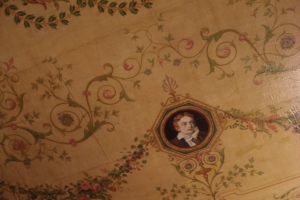
Although an effort has been made to make the interior of the house look a little less institutional than in the recent past, it did strike me how strange it was that there was not one visual reference to the long Garrett occupation. For instance, a series of etchings (I think) of what appeared to be northern European market towns, while being attractive, do nothing to give meaning to the rooms in which they are hung.
Coincidentally, a few days after that talk, I saw an advertisement for Royal Holloway’s MA in Creative Writing, one of the ‘pathways’ of which is ‘Environmental Writing’ (‘Place, Environment, Writing’). Looking at the website I saw that the accompanying photograph shows Prof Andrew Motion, the biographer of Keats, whose portrait the Garretts included in the ceiling next door, conducting a seminar in the Garretts’ drawing room. How ironic, I thought, that they should be discussing a sense of place in a place from which all sense of a past has been excluded.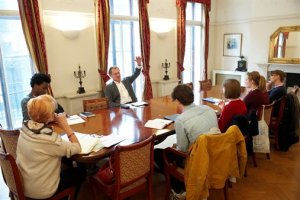
I emailed Andrew Motion to make this point and received an immediate and very supportive reply – suggesting I write to his head of department. Well, I did so, but met with silence. I suppose universities have more pressing matters to attend to.
But how easy and inexpensive it would be to add a few pictures to that seminar room and show an awareness of its past history.
For instance, an enlargment of this – showing the same room in 1875 – as depicted in Rhoda and Agnes’s book, House Decoration.
And here is a photograph, held in the National Portrait Gallery, of Agnes attending to the grandfather clock in the corner just to the left of the fireplace. The portrait in the background is that of Philippa Fawcett by Harold Rathbone. And here is Millicent Fawcett conducting the women’s suffrage campaign from her desk in the corner on the fireplace’s right.
That is just a beginning – I could suggest many more illustrations – all inexpensive to access – of designs, people and occasions that would bring a sense of place back to the house that was the centre of so much activity during the last quarter of the 19th century and the first quarter of the 20th. How pleased I would be if Royal Holloway were to take my suggestion seriously.
For much more about Millicent Fawcett and Agnes Garrett see Elizabeth Crawford, Enterprising Women: the Garretts and their circle
Music For Garrett Rooms: Hubert Parry’s ‘English Lyrics’
Posted by womanandhersphere in The Garretts and their Circle on July 22, 2012
 The most detailed account of Rhoda and Agnes Garrett at work as ‘house designers’ is, as far as I have been able to establish, recorded in the diary of the composer, Hubert Parry. He was their close friend and in May 1876 stayed with them for a fortnight in 2 Gower Street, afterwards writing in his diary:
The most detailed account of Rhoda and Agnes Garrett at work as ‘house designers’ is, as far as I have been able to establish, recorded in the diary of the composer, Hubert Parry. He was their close friend and in May 1876 stayed with them for a fortnight in 2 Gower Street, afterwards writing in his diary:
’To live in their house is a very great deal of happiness in itself. The quiet and soothing colour of the walls and decoration and the admirable taste of all things acts upon the mind in the most comforting manner. I was quite excised of the vulgar idea that everything ought to be light & gaudy & covered with gilt in London. All these are a sure element of discomfort in a house, ones eye wants rest & nothing shows the dirt & dust of London so soon as light colours & gilding’.
Later in 1876 Rhoda and Agnes were commissioned to decorate Parry’s new house in Phillimore Place, Kensington.
In 1881 Parry chose to build his country house, Knights Croft, just across from the back garden of Rhoda and Agnes’s cottage in Rustington, Sussex.. There he provided members of the Garrett circle with many evenings of musical entertainment. In my first draft of Enterprising Women I included the suggestion that while reading Chapter 4 – that discussing Rhoda and Agnes’s careers as interior designers – a background accompaniment of Parry’s Songs might be appropriate. This suggestion was excised by a (prosaic) editor and I did not have the gumption to remonstrate.
Here, however, I can now suggest you listen to some excerpts from ‘Parry’s English Lyrics’.
Don’t you think that they add another dimension to a study of the work of ‘R & A Garrett’?
This music, so fluent, so English, was made to be played in the rooms that the cousins designed, composer and decorator each in their own way bringing comfort and harmony to the middle classes. The music also speaks of the patriotism and imperialism that was dear to the Garretts and their circle.
For more about Rhoda and Agnes Garrett and their work see:
Elizabeth Crawford, Enterprising Women: the Garretts and their circle, published by Francis Boutle
Click here for details
£25
Mrs Millicent Vince: Pupil of Agnes Garrett And Interior Decorator
Posted by womanandhersphere in The Garretts and their Circle on July 22, 2012
 In the post ‘Garrett Laburnum’ I mentioned that I had come across a sliver of wallpaper designed by Rhoda and Agnes Garrett as a photo in a book by one of Agnes’ pupils, Millicent Vince. Being curious, I wondered what I could find out about Mrs Vince and her work.
In the post ‘Garrett Laburnum’ I mentioned that I had come across a sliver of wallpaper designed by Rhoda and Agnes Garrett as a photo in a book by one of Agnes’ pupils, Millicent Vince. Being curious, I wondered what I could find out about Mrs Vince and her work.
I discovered that she had been born Emily Cohen in Birmingham in 1868, the daughter of Adolph Cohen, a Hamburg-born watchmaker and diamond dealer. There was clearly artistry in the family; one of Adolph’s watch case designs (1871) is held in the National Archives Design Register. Her mother, Juliana, was Scottish. Emily, who was known as ‘Millie’ or ‘Millicent’, had 3 sisters and a brother, the family living for many years at 27 Frederick Street, in the city’s Jewellery Quarter. Her brother, David, also became a diamond dealer, eventually moving out of Birmingham to live at The Old Stone Manor, Upper Oddington, Gloucestershire.
I would imagine that the family was Jewish, although it would seem doubtful that Millicent, at least, was observant. There is no hint of the sisters having any paid occupation until, after their father’s death, in the 1901 census the eldest sister, Jessie, is shown as running a typewriting agency. Emily is living at home.
However, in the 1911 census Jessie no longer has an occupation, while the 1908 London Directory that I happen to have to hand shows ‘Miss M. Cohen’ running her own business as an Interior Decorator from Oakley House (14,16,18 Bloomsbury Street).There is no trace of Emily Cohen in the 1911 census, either under her given name or her diminutives. She was at that time living at 68 Great Russell Street, just round the corner from her office, but is not listed in the enumerator’s book as being expected to be there on census night. I would not, however, jump to the conclusion that she is absent because she heeded the suffragette call to boycott the census. There is likely to be a more prosaic explanation – such as a holiday abroad.
So in 1908 Millicent Cohen was living just down the road from Agnes Garrett’s house at 2 Gower Street. Did her pupillage with Agnes Garrett occur after 1901? – perhaps between then and Agnes’ retirement in 1905? The fact that she chose to set up business so close by might indicate that she inherited the goodwill of Agnes’s business. She clearly was very fond of her, dedicating Decorating and Care of the Home to ‘Agnes Garrett Pioneer of Women House-Decorators My Teacher and Friend’ and writing of her in the feminist paper, The Woman’s Leader, in 1925.
Millicent’s training probably followed closely that which Rhoda and Agnes had enjoyed. In a footnote she reveals that as a student she made drawings of the woodwork – mantelpieces and panelling – from building such as Aston Hall, Juniper Hall and Kew Palace; Rhoda and Agnes had had entry for just such a purpose to many of the great houses of England.
On reading Decorating and Care of the Home it is obvious that Millicent Vince shared many of the views on what constituted an ideal home as set out by Rhoda and Agnes Garrett nearly 50 years earlier in House Decoration (Macmillan, 1875). The emphasis is always on light and simplicity.
For instance, for country cottages Mrs Vince recommends the Swedish style – light-painted furniture, perhaps decorated with discreet stencils – thinking this preferable to the dark ‘country’ furniture usually thought suitable. This is a timeless look: today’s ‘country decorating’ magazines such as Country Living and Homes and Antiques usually feature at least one home dressed in such a style. In fact Mrs Vince clearly had a penchant for Sweden – leaving bequests in her will to two Swedish friends, one being the 1912 Olympic tennis player, Ebba Hay.
After setting up in business Miss Cohen soon made a name for herself, being quoted thus in article by Sarah Tooley, published in the Everywoman Encyclopaedia around 1910. ‘Are you not afraid of your workmen?” a lady asked Miss M. Cohen, one of our most accomplished designers and decorators. “Afraid of my workmen?” replied Miss Cohen. “Why, I count them all among my friends. They are willing, polite, and obliging, and it has done me good to know them.” This was very much the attitude to her workforce that Agnes Garrett had displayed throughout her working life.
Having probably not commenced in business until she was in her mid-30s, Millicent Cohen’s life took an interesting turn when, in 1915, she married Charles Vince. He was the son of a Cambridge fellow (and former headmaster of Mill HillSchool), had been educated in Birmingham and, when they married, was 28 to her 48. I am not sure whether or not she continued in business. After her marriage she no longer appears to have an office address, but the telephone directory lists ‘Mrs M. Vince’ rather than Charles. After the war he was in full-time employment as publicity secretary of the Royal Naval Lifeboat Institution and may not have needed the listing for professional purposes – while Millicent did. But that is perhaps a deduction too far.
After a brief sojourn in Hampstead Garden Suburb (Mrs Vince, while finding the Suburb’s cottages agreeably quaint on the outside, is a little scathing about their practicality), the couple lived in Brunswick Gardens, Kensington, first at 42 and, after 1936, at 27.
 Although in her book Mrs Vince mentions in passing many decorating commissions that she had undertaken, all of them are anonymous. If it was difficult to identify Agnes Garrett’s clients, it seems impossible now to discover those to whom Mrs Vince brought the luxury of tranquil surroundings. For that was her aim. This photograph is taken from Decorating and Care of the Home and I rather think is of a room in her own apartment. The wallpaper looks very much like Morris’s ‘Willow Bough’, the paper she had selected for illustration alongside ‘Garrett Laburnum’.
Although in her book Mrs Vince mentions in passing many decorating commissions that she had undertaken, all of them are anonymous. If it was difficult to identify Agnes Garrett’s clients, it seems impossible now to discover those to whom Mrs Vince brought the luxury of tranquil surroundings. For that was her aim. This photograph is taken from Decorating and Care of the Home and I rather think is of a room in her own apartment. The wallpaper looks very much like Morris’s ‘Willow Bough’, the paper she had selected for illustration alongside ‘Garrett Laburnum’.
Apart from her books, Millicent Vince’s will is the only document I have seen that gives any other clue to her personal life. In that she makes clear her affection for her husband and siblings and, among many bequests, are ones to the woman-run Lady Chichester Hospital at Hove and one of its doctors, Dr Helen Boyle, and to Kensington feminist designer and enameller, Mrs Ernestine Mills.
Mrs Vince’s other two books are Furnishing and Decorating Do’s and Don’ts, Methuen, 1925 and Practical Home Decorating: how to choose your decorations and how to carry them out yourself, Pitman, 1932. Here are details of the copy of Decorating and Care of the Home that I have for sale.
For more on Rhoda and Agnes Garrett ‘House Decorators’ see Elizabeth Crawford, Enterprising Women: the Garretts and their circle.
‘Garrett Laburnum’
Posted by womanandhersphere in The Garretts and their Circle on July 17, 2012
One of the pleasures in working on the creation of the Elizabeth Garrett Anderson Gallery was to be able to help bring back to life the only surviving wallpaper created by the firm of ‘Rhoda and Agnes Garrett Household Decorators’.
I first came across the design in the form of a small, rather indistinct, black and white photograph in Decoration and Care of the Home by Mrs Millicent Vince.
 The book was published in 1923 and is dedicated to Agnes Garrett, with whom Millicent Vince had trained. The photograph labelled ‘Garrett Laburnum’ appears alongside one of ‘Willow Bough’, created by William Morris in 1887. ‘Garrett Laburnum’ is likely to date from around the same time..
The book was published in 1923 and is dedicated to Agnes Garrett, with whom Millicent Vince had trained. The photograph labelled ‘Garrett Laburnum’ appears alongside one of ‘Willow Bough’, created by William Morris in 1887. ‘Garrett Laburnum’ is likely to date from around the same time..
Although we do not know exactly how the original wallpaper was coloured, wallpaper artist Pip Hall did a wonderful job of re-creating ‘Garrett Laburnum’ using the soft greens and yellows that surviving comments indicate were predominant in Agnes Garrett’s palette.
Click here to see how ‘Garrett Laburnum’ is displayed in the Elizabeth Garrett Anderson Gallery.
For Pip Hall click here
For much more information about Rhoda and Agnes Garrett as the first women professional decorators see Elizabeth Crawford, Enterprising Women: the Garretts and their circle.


